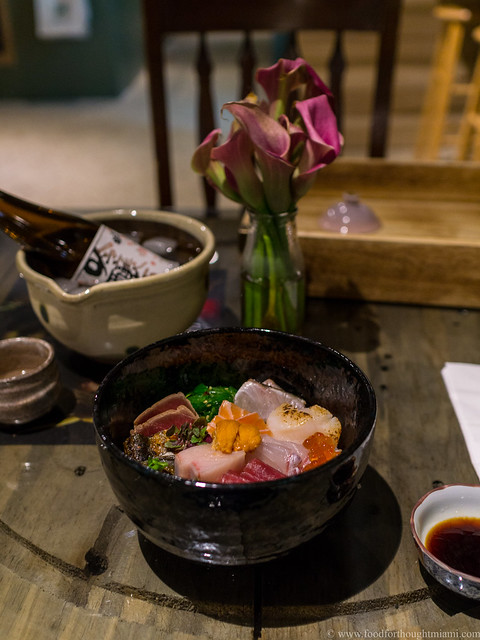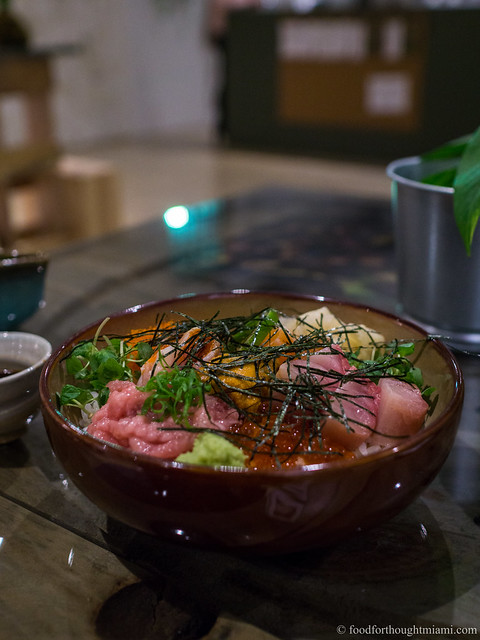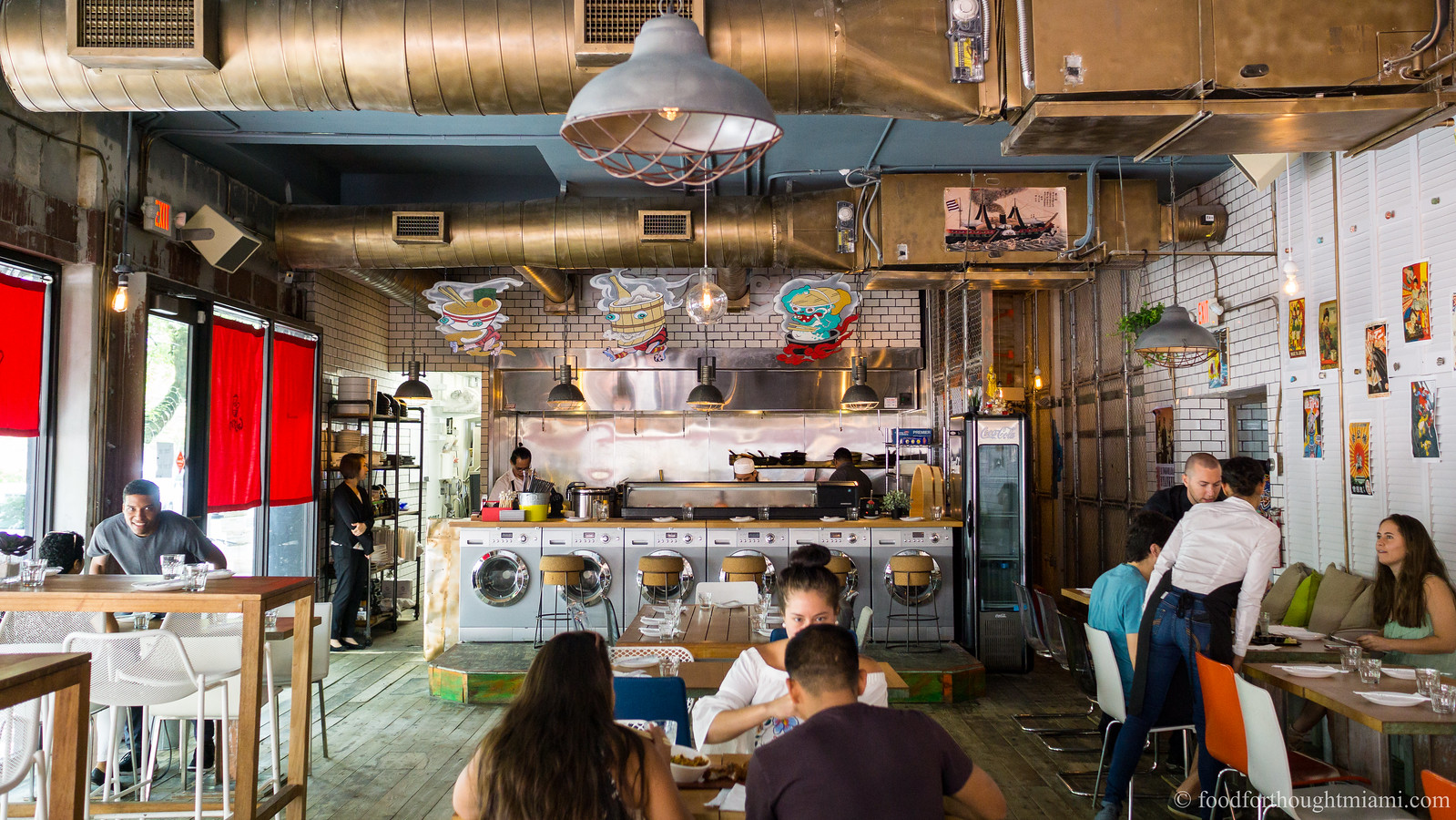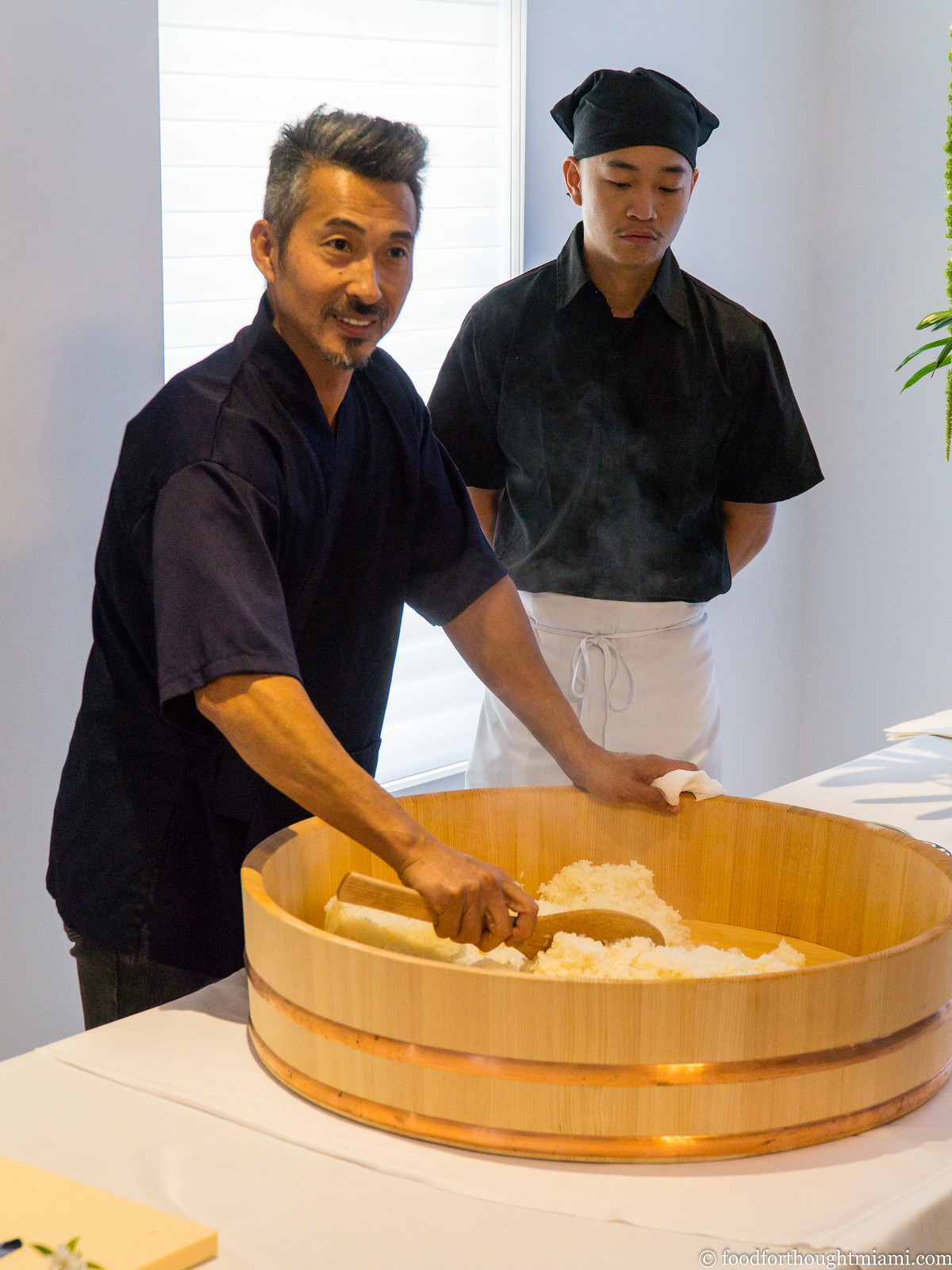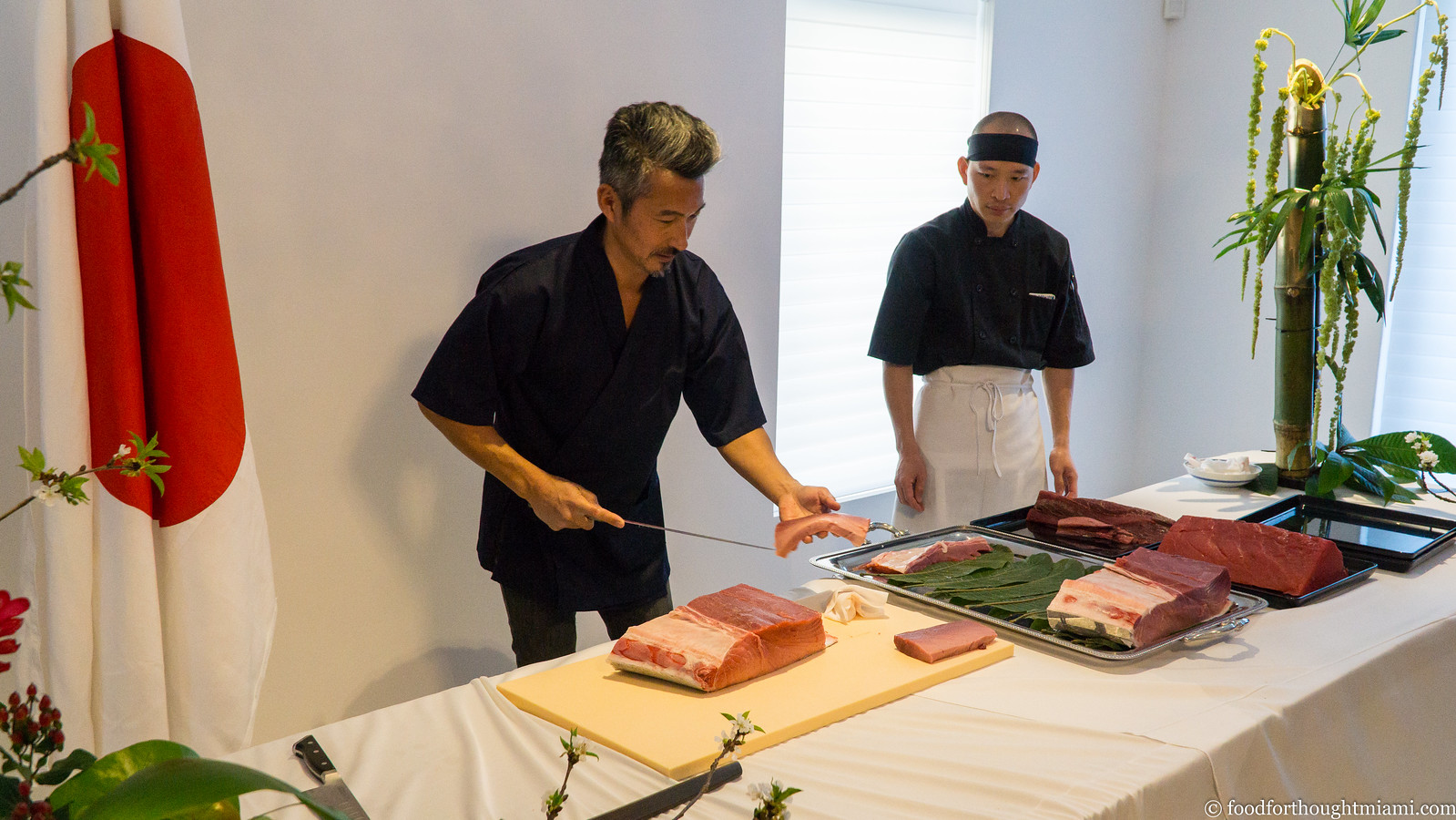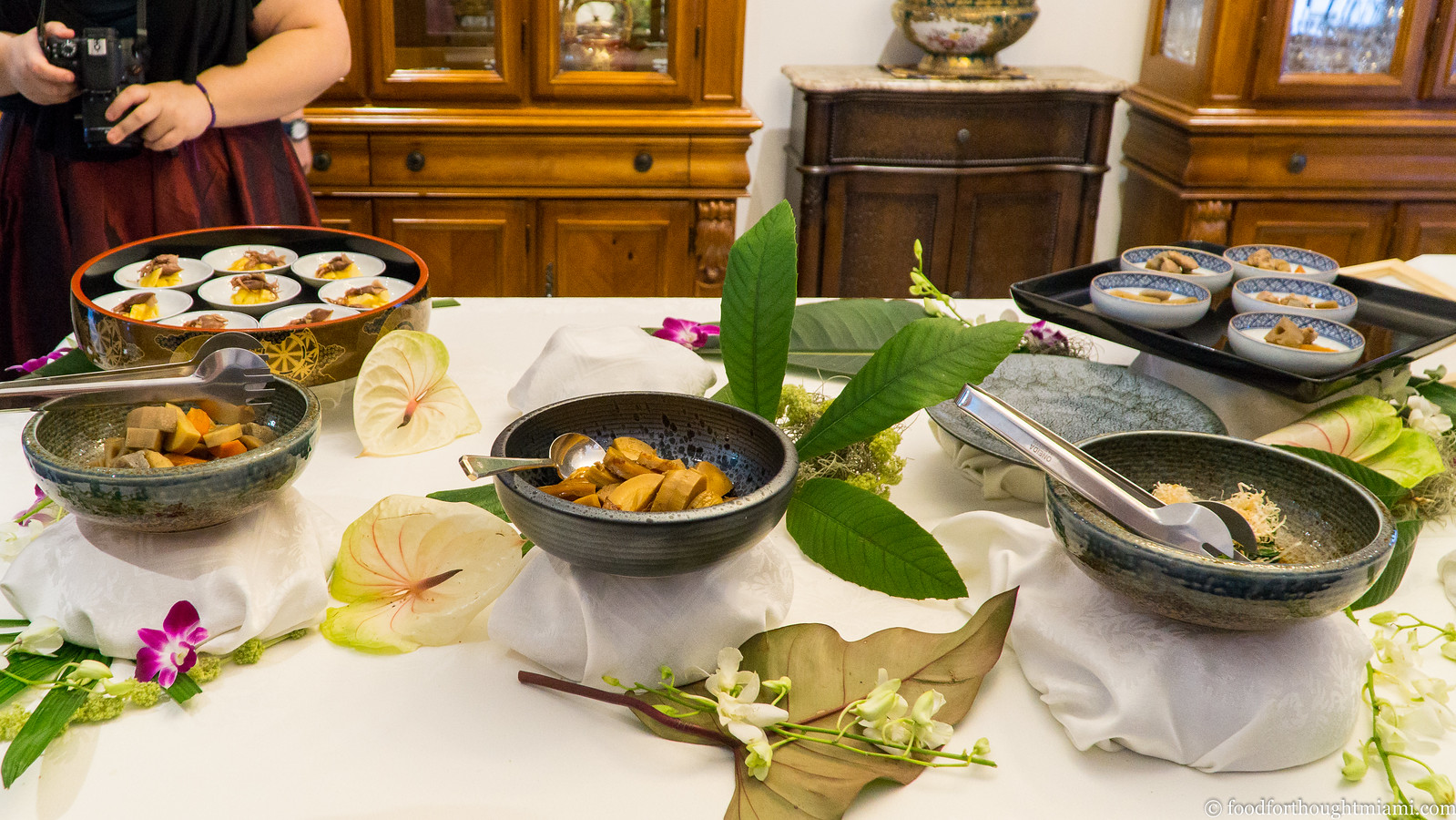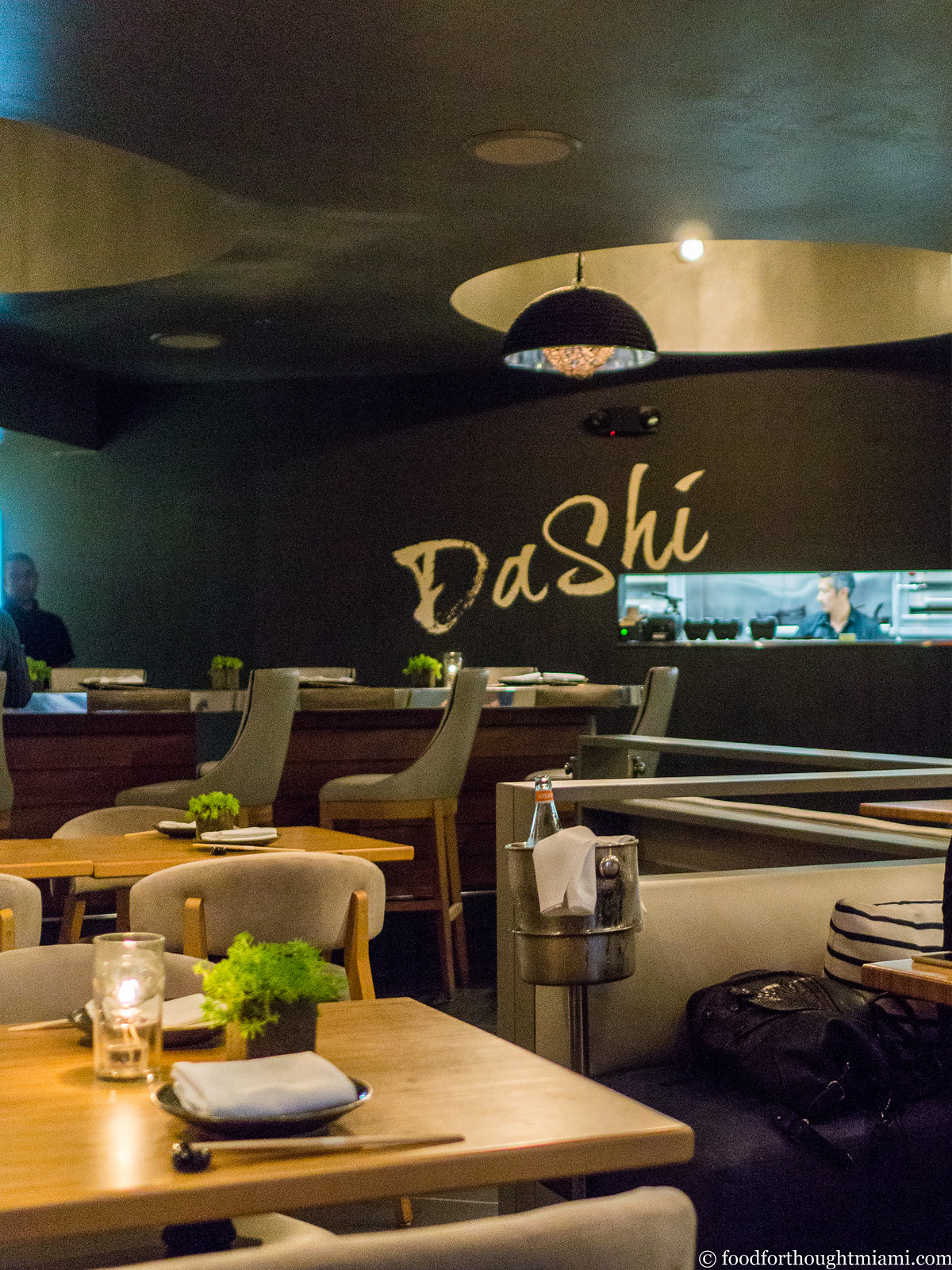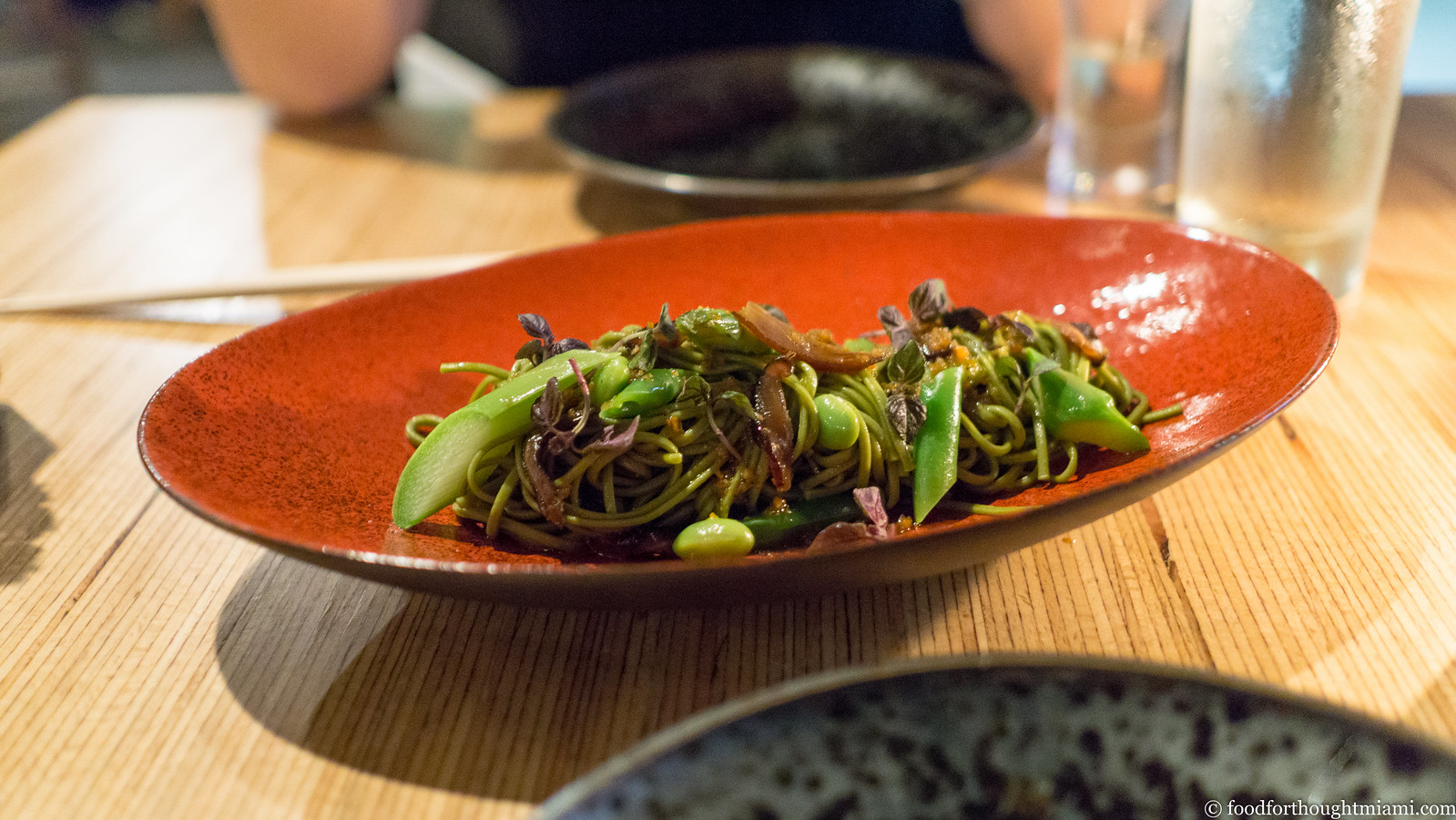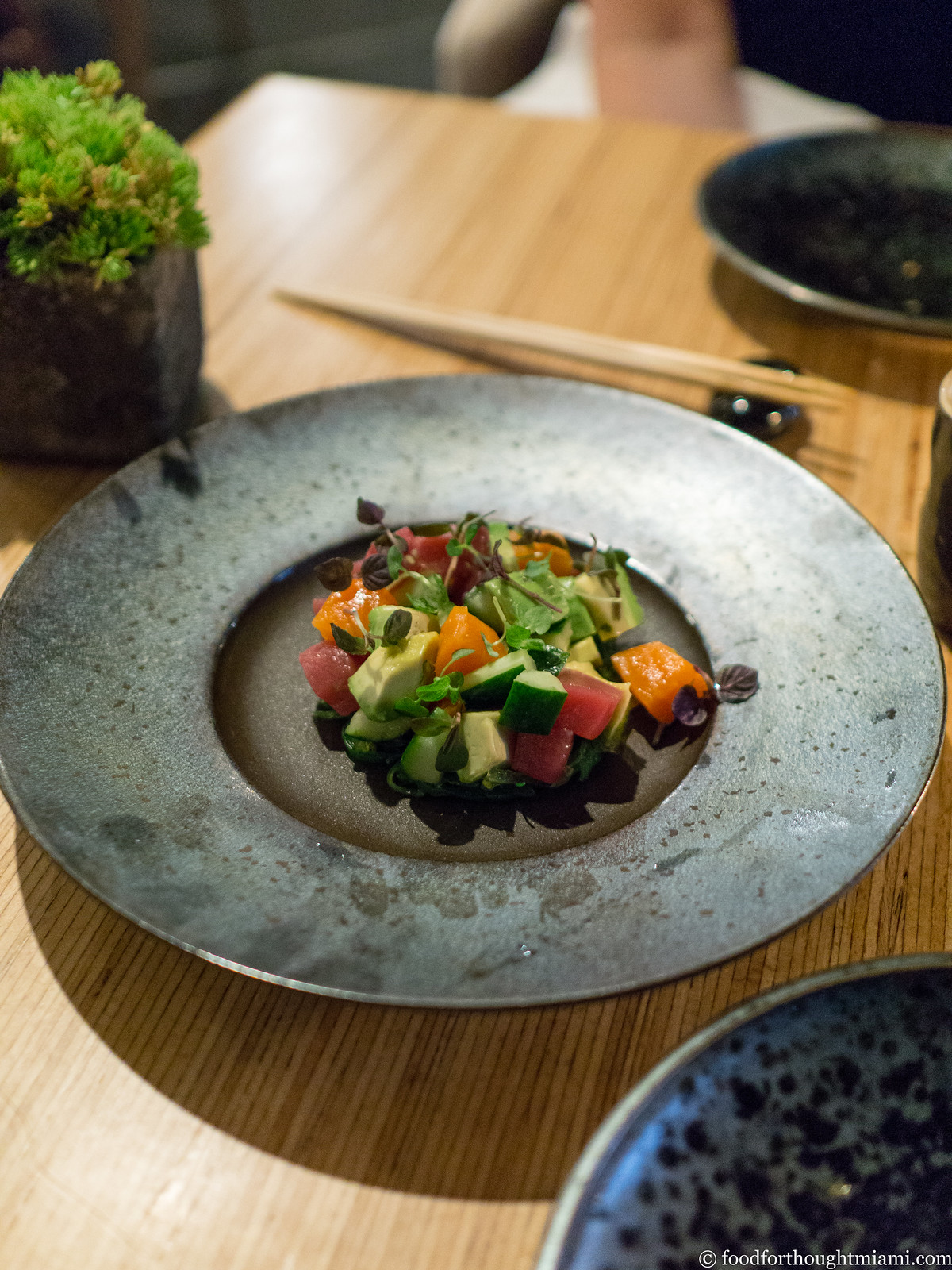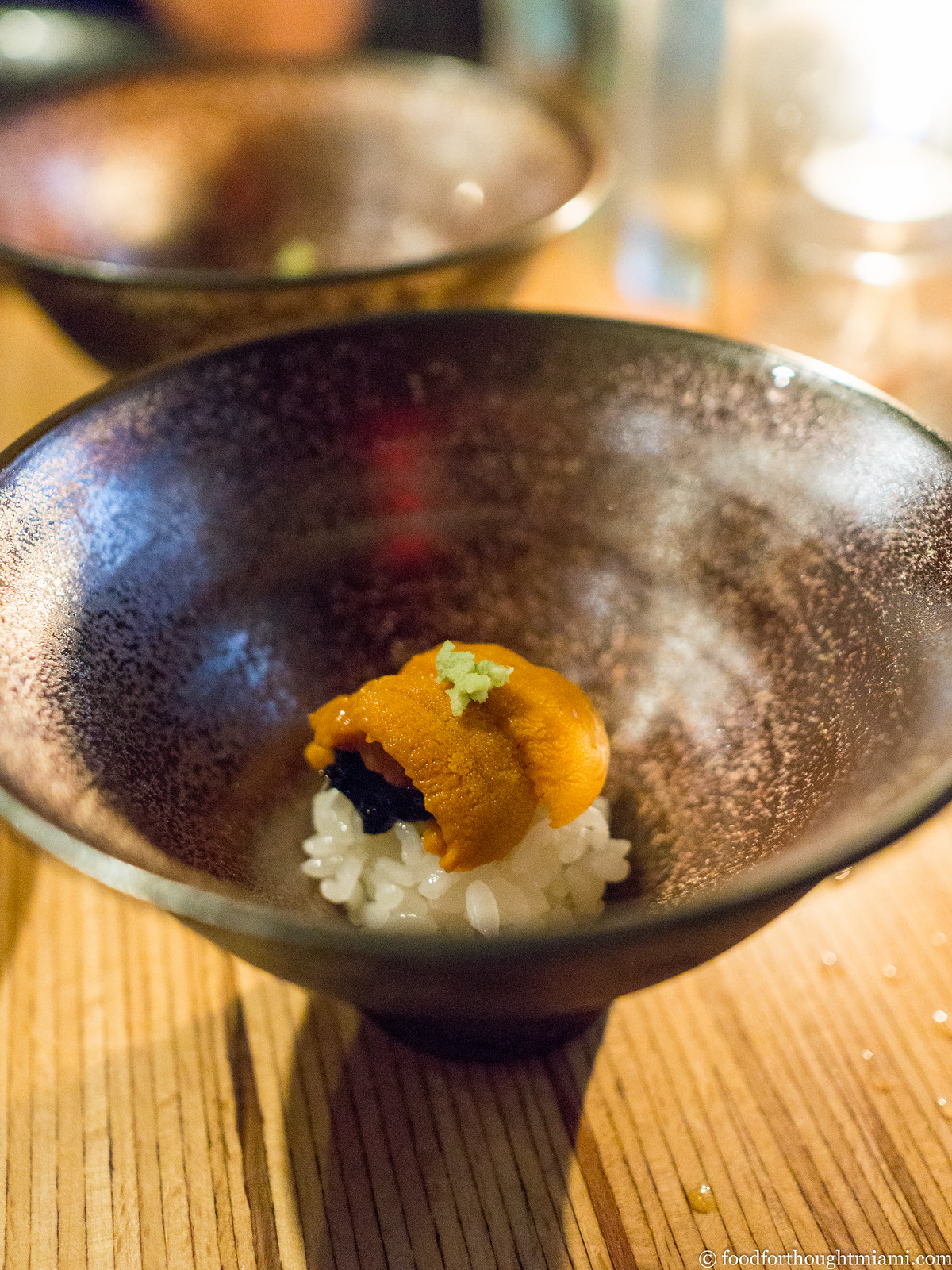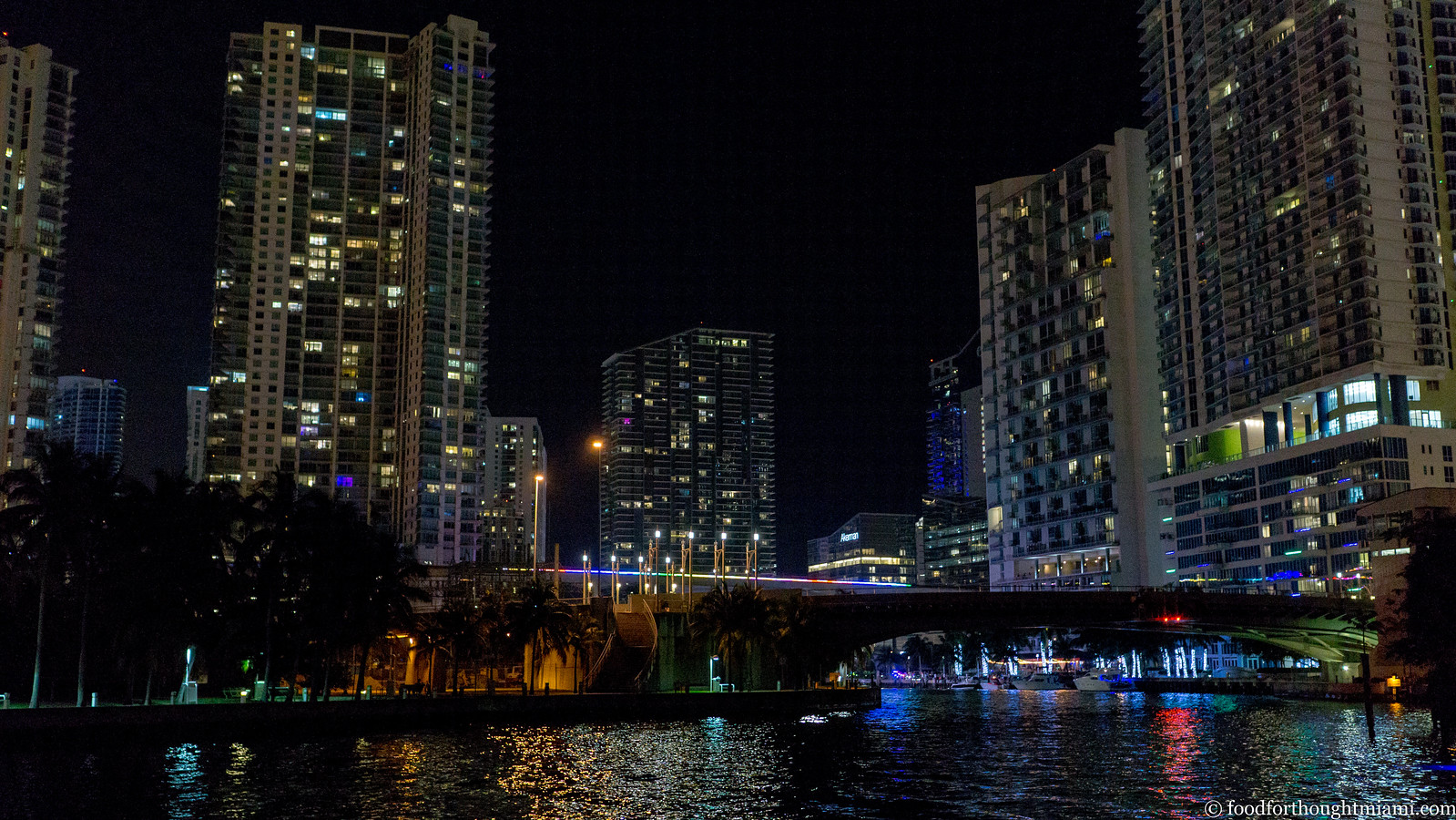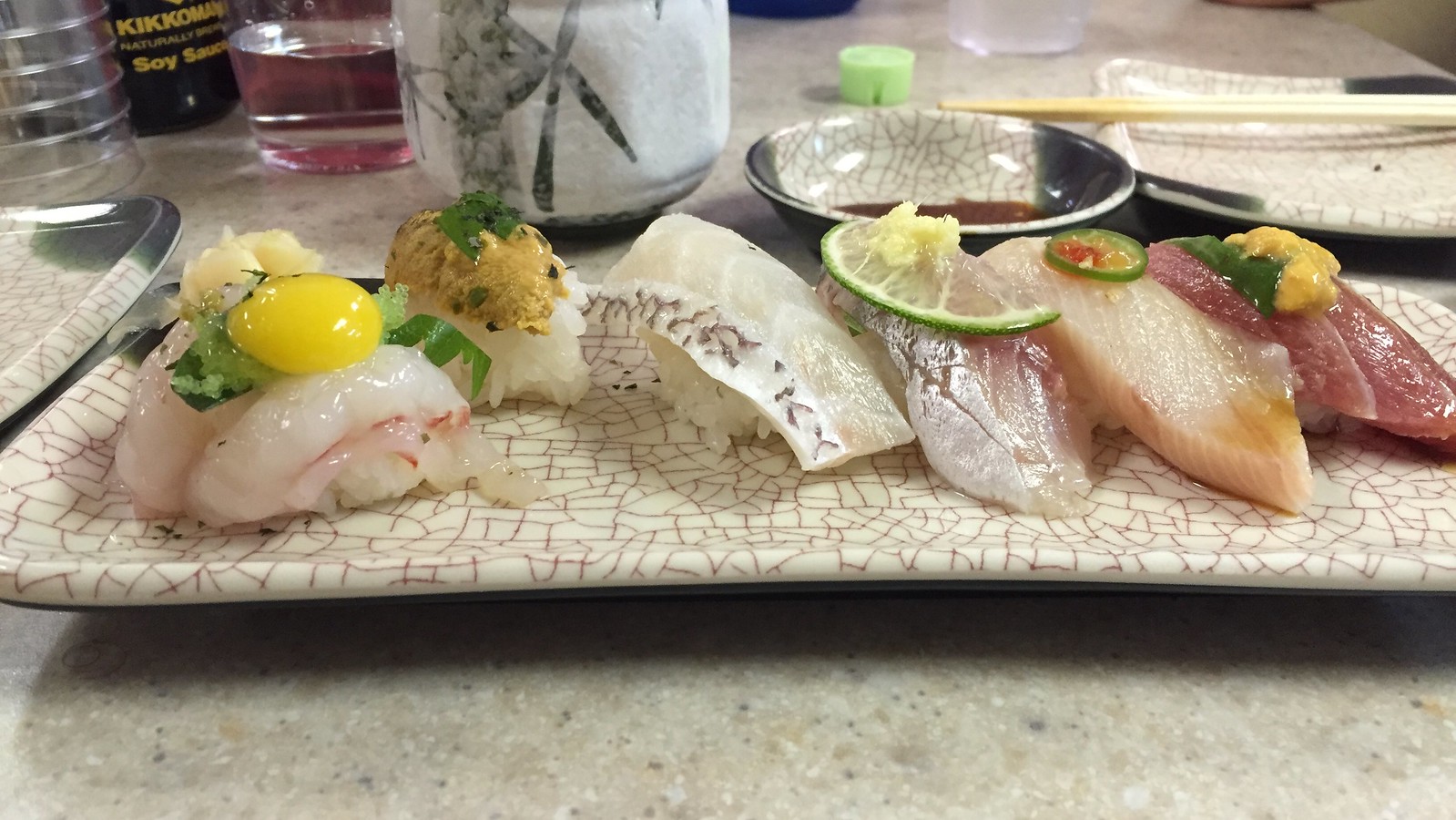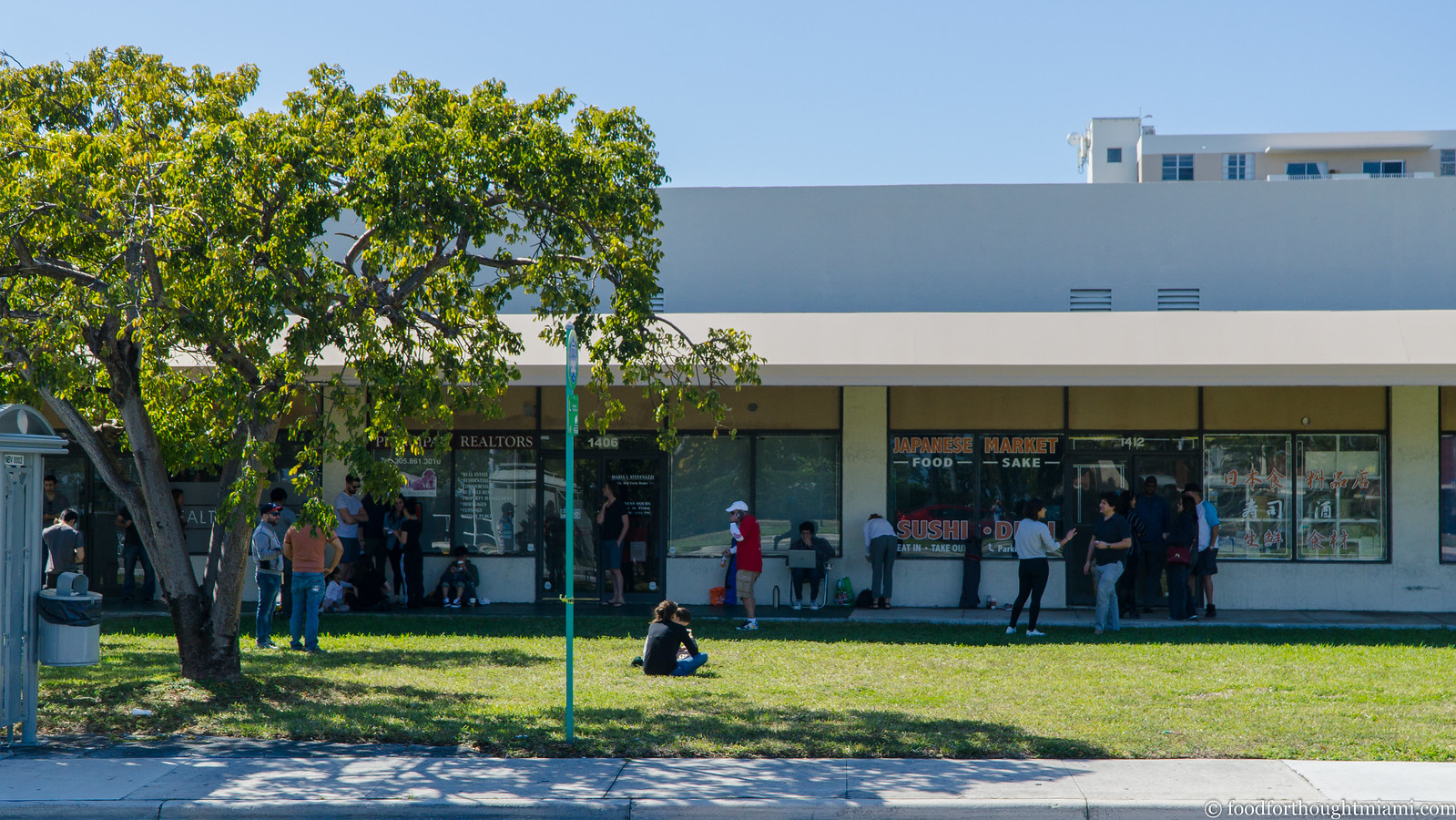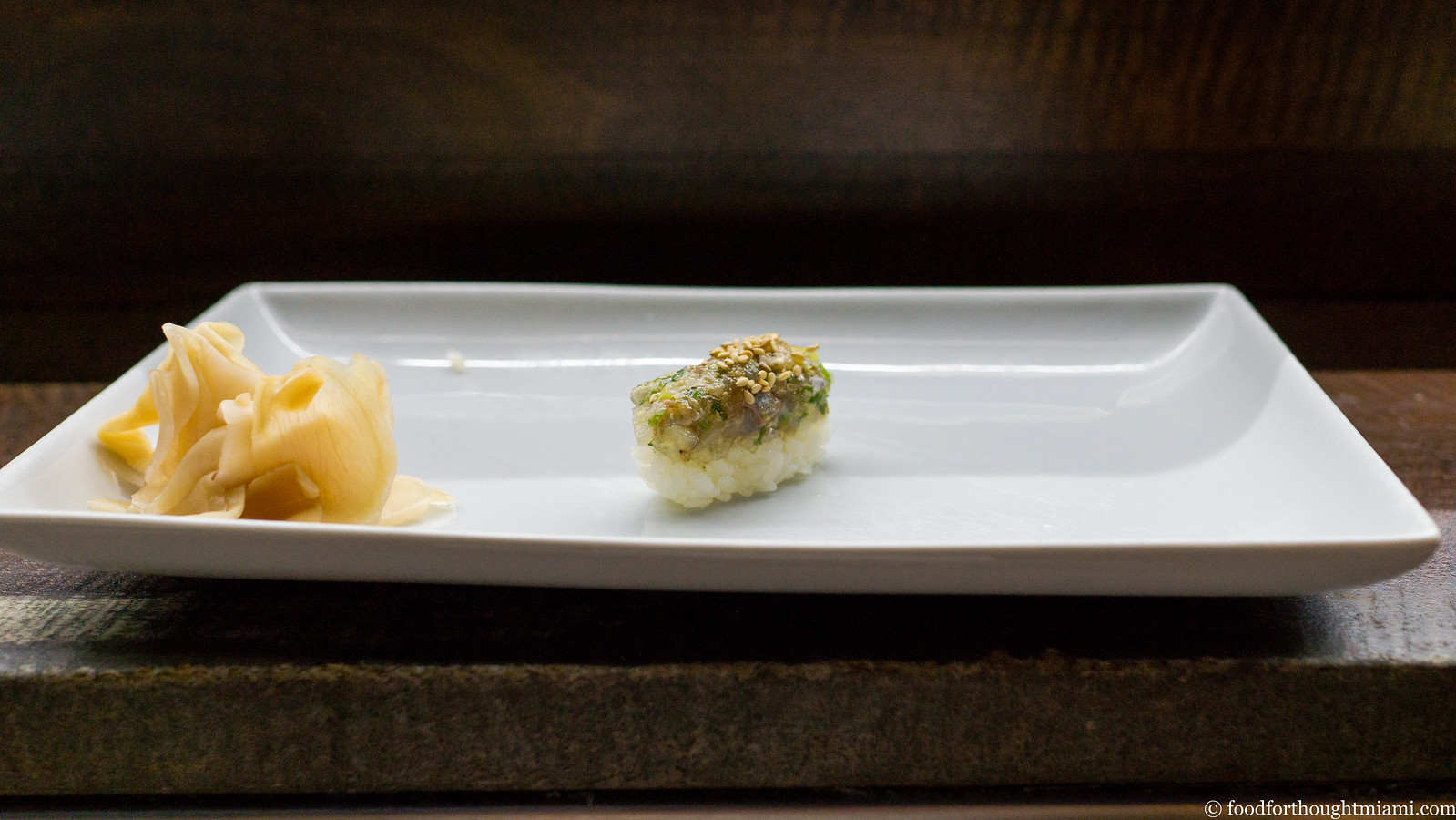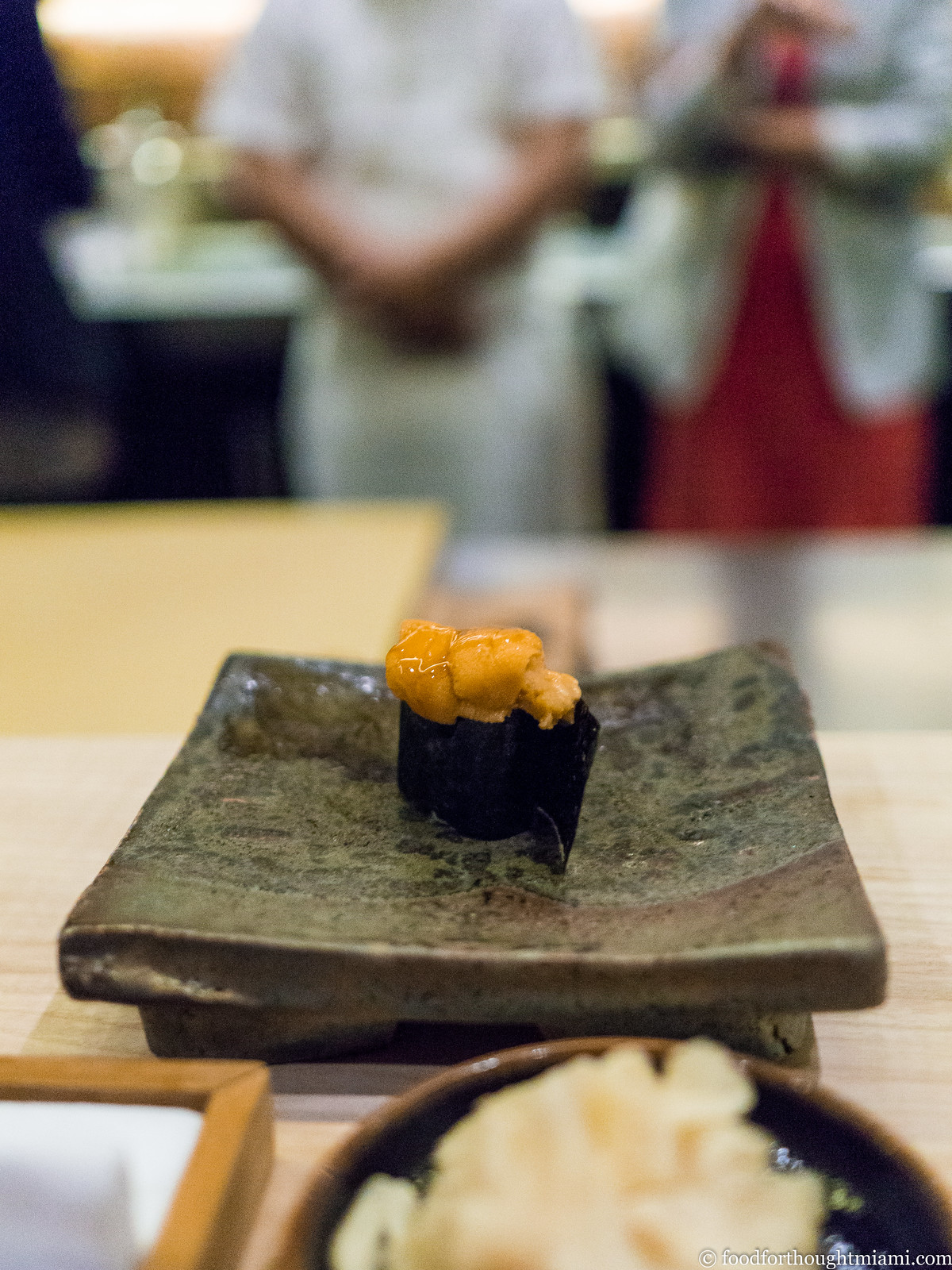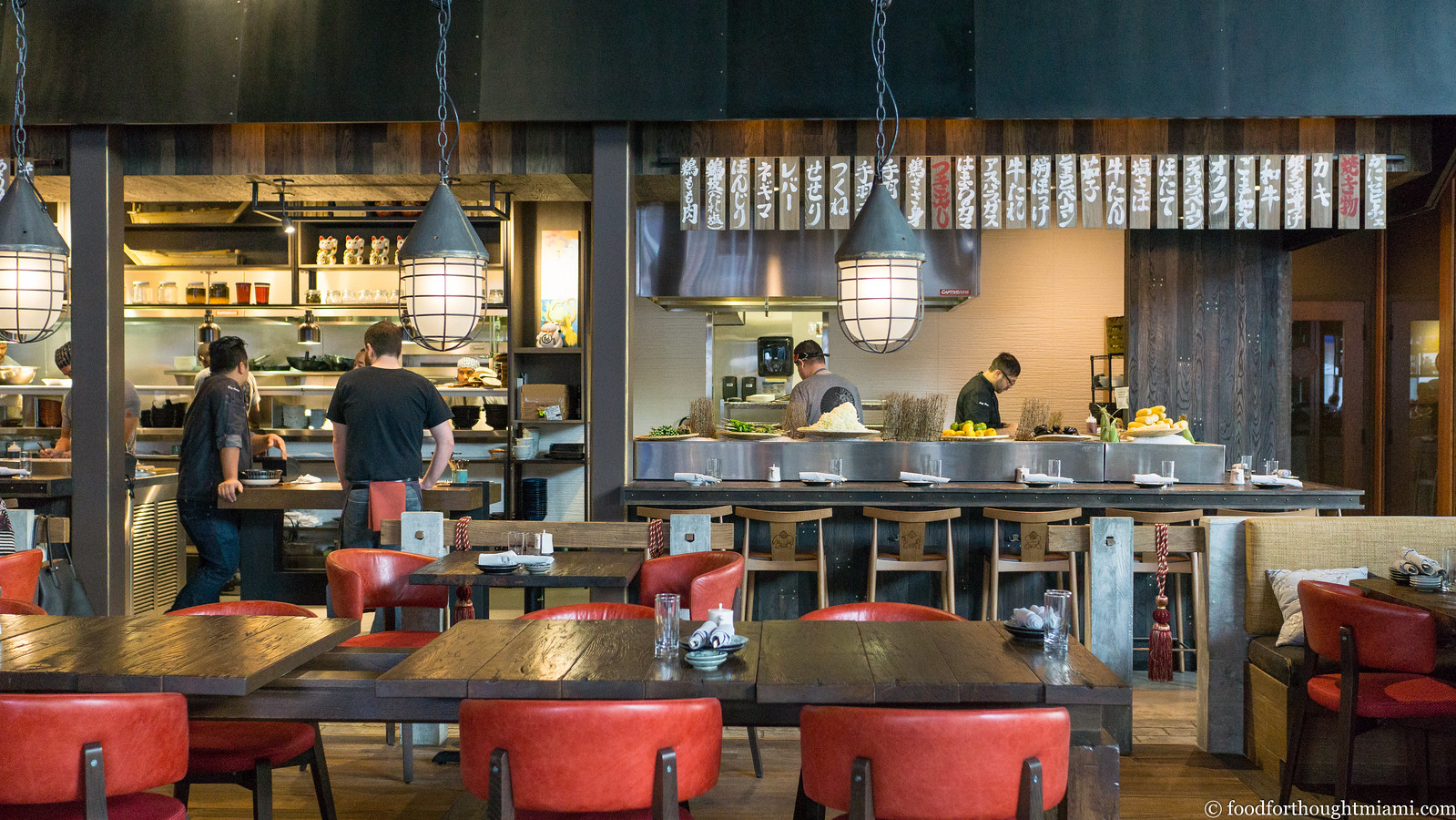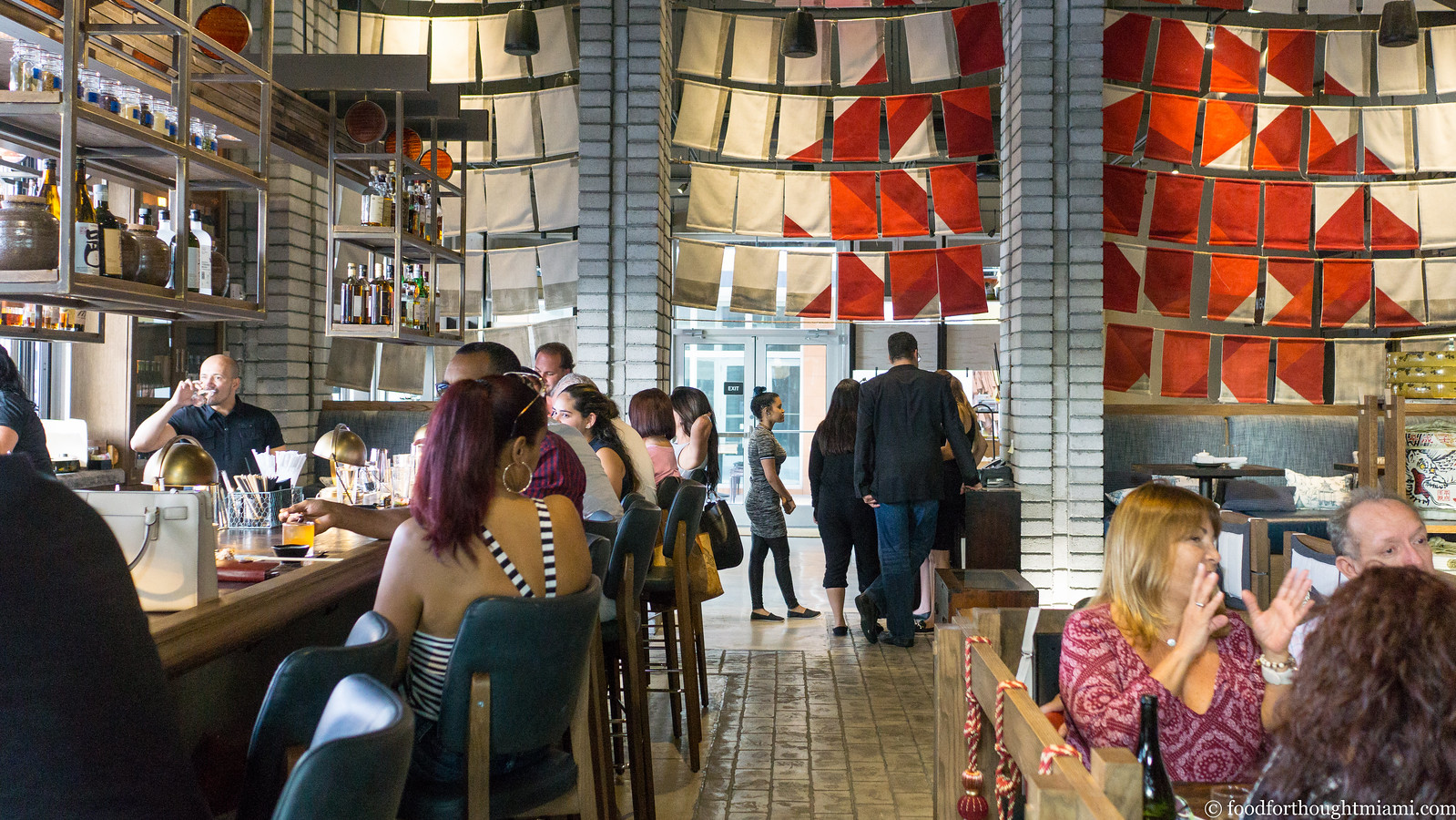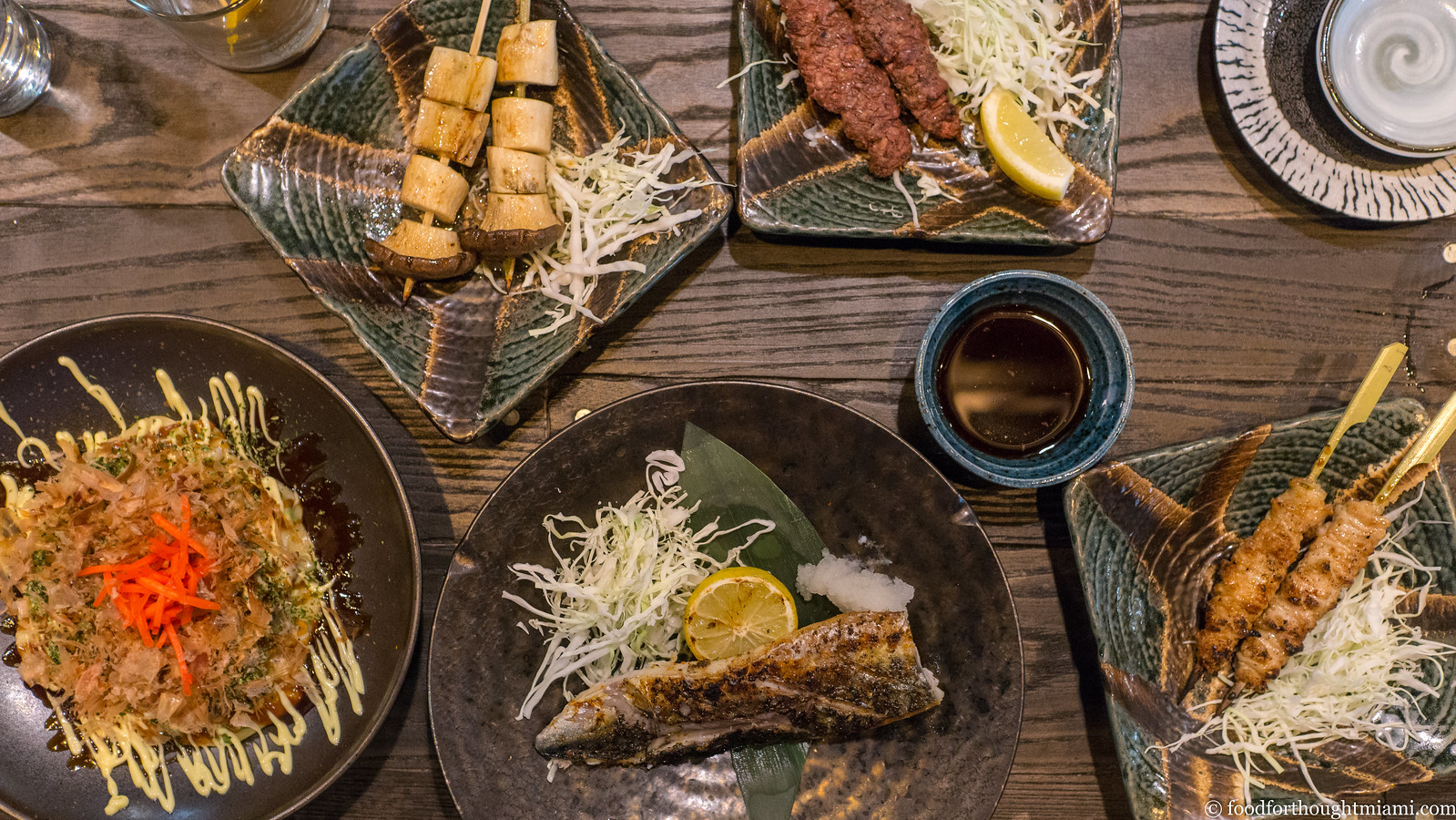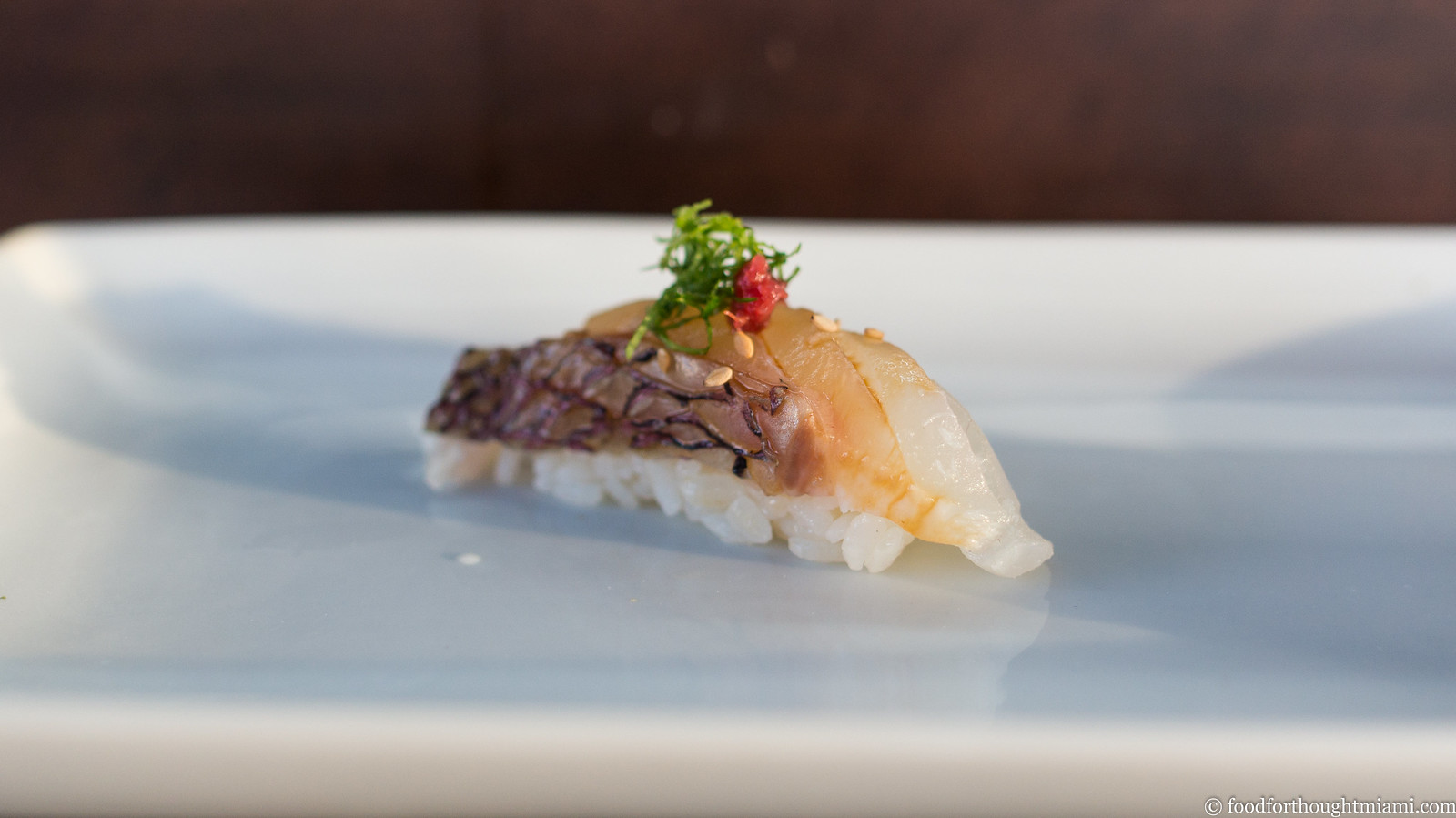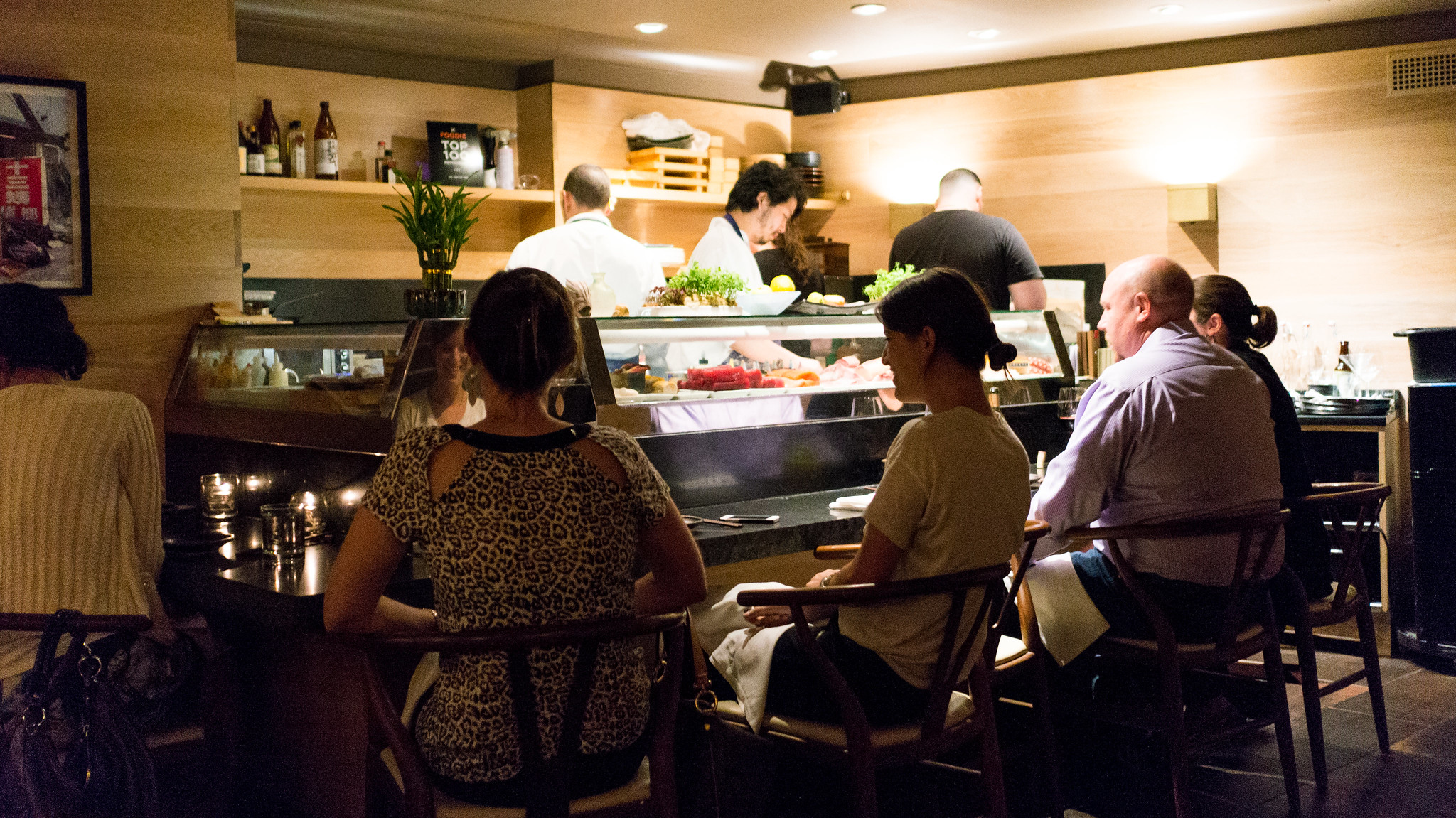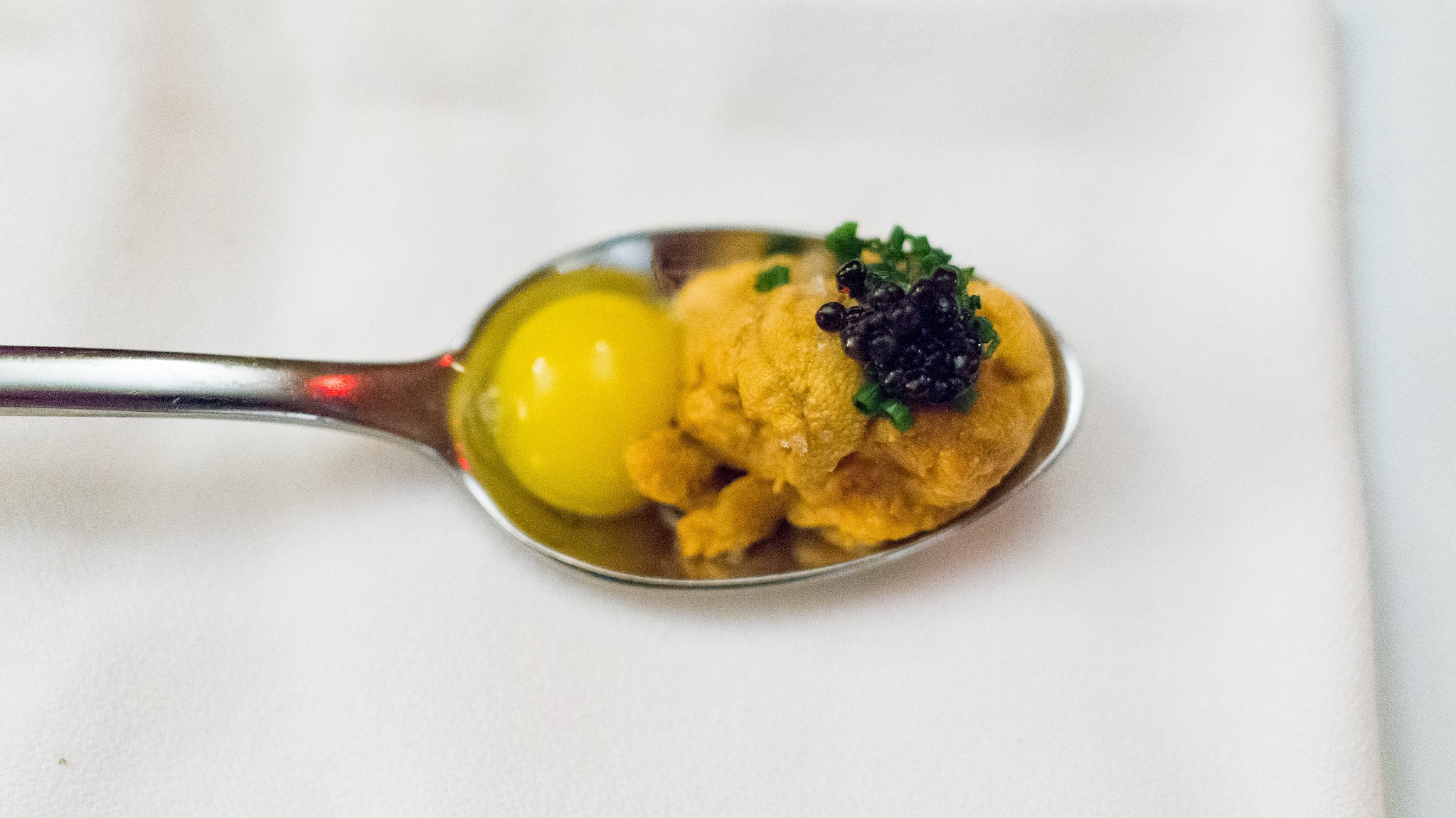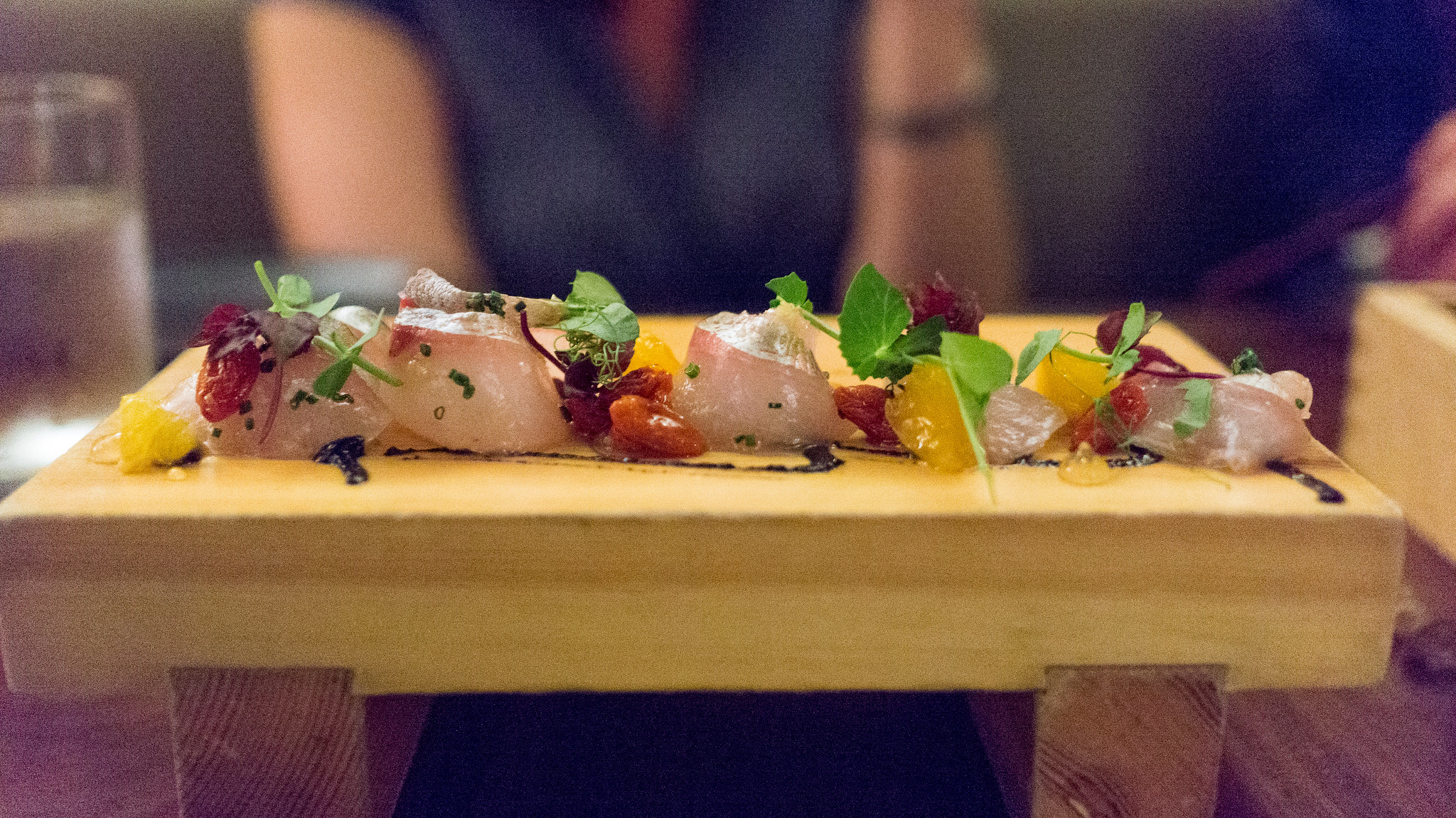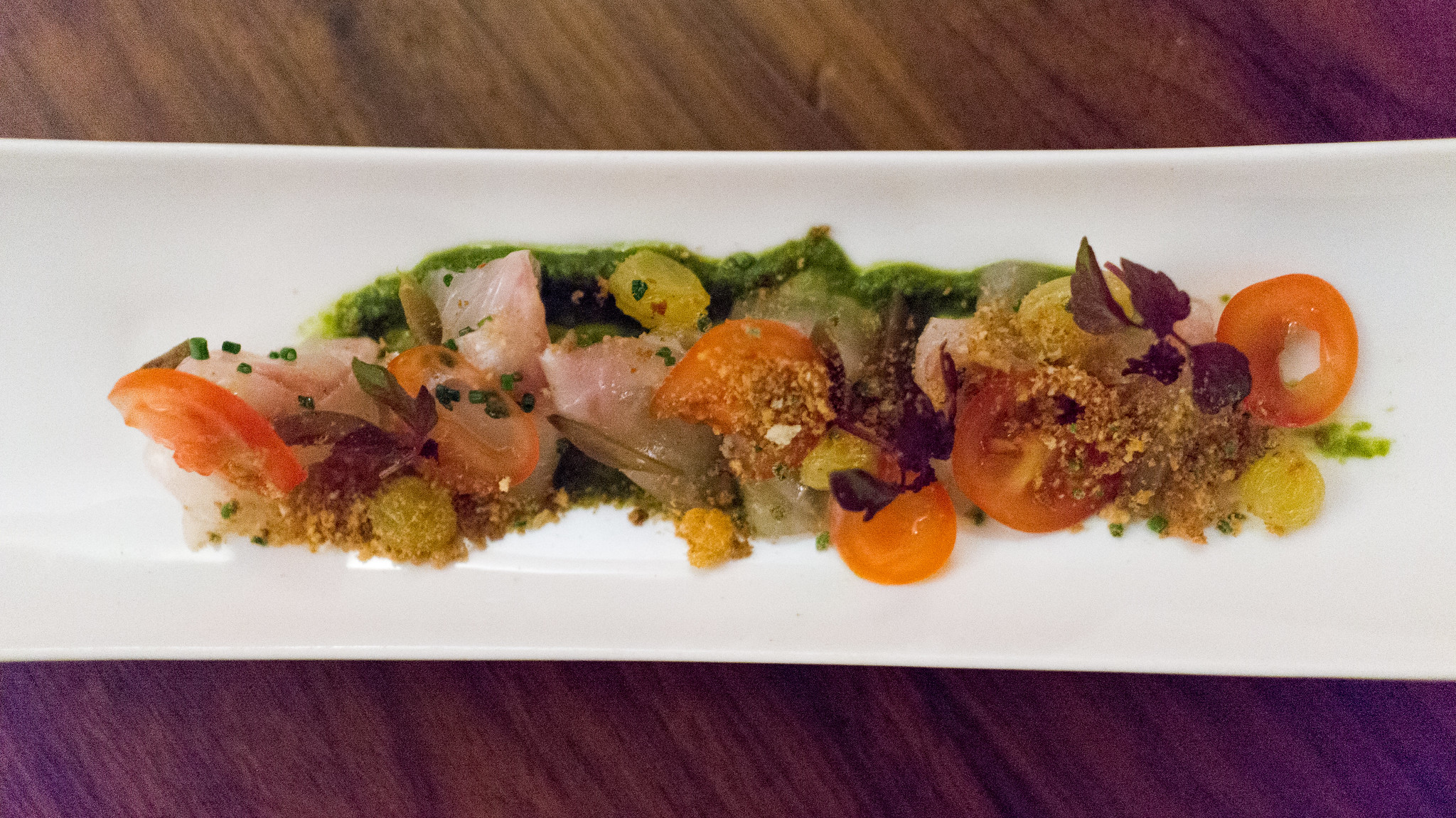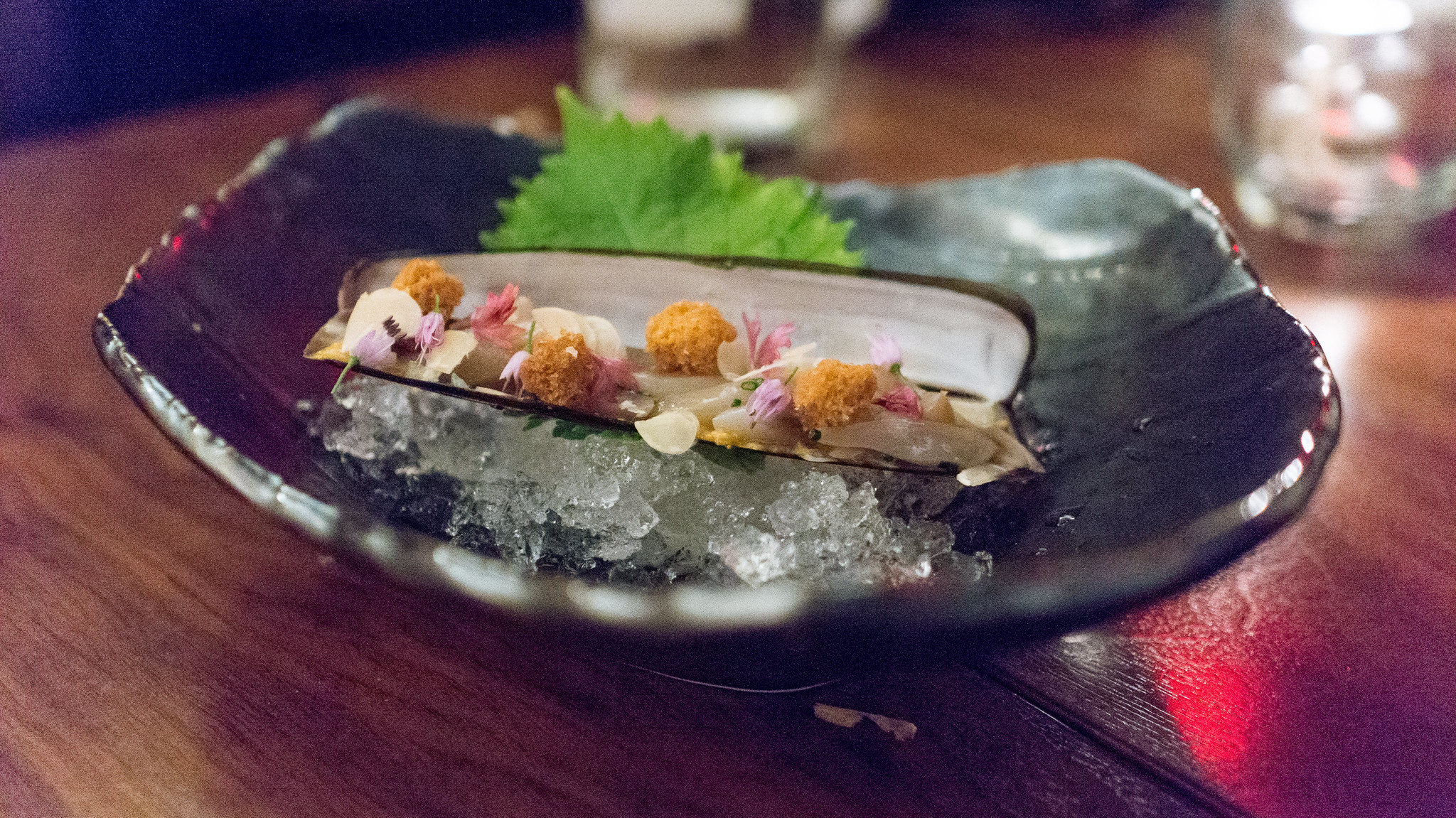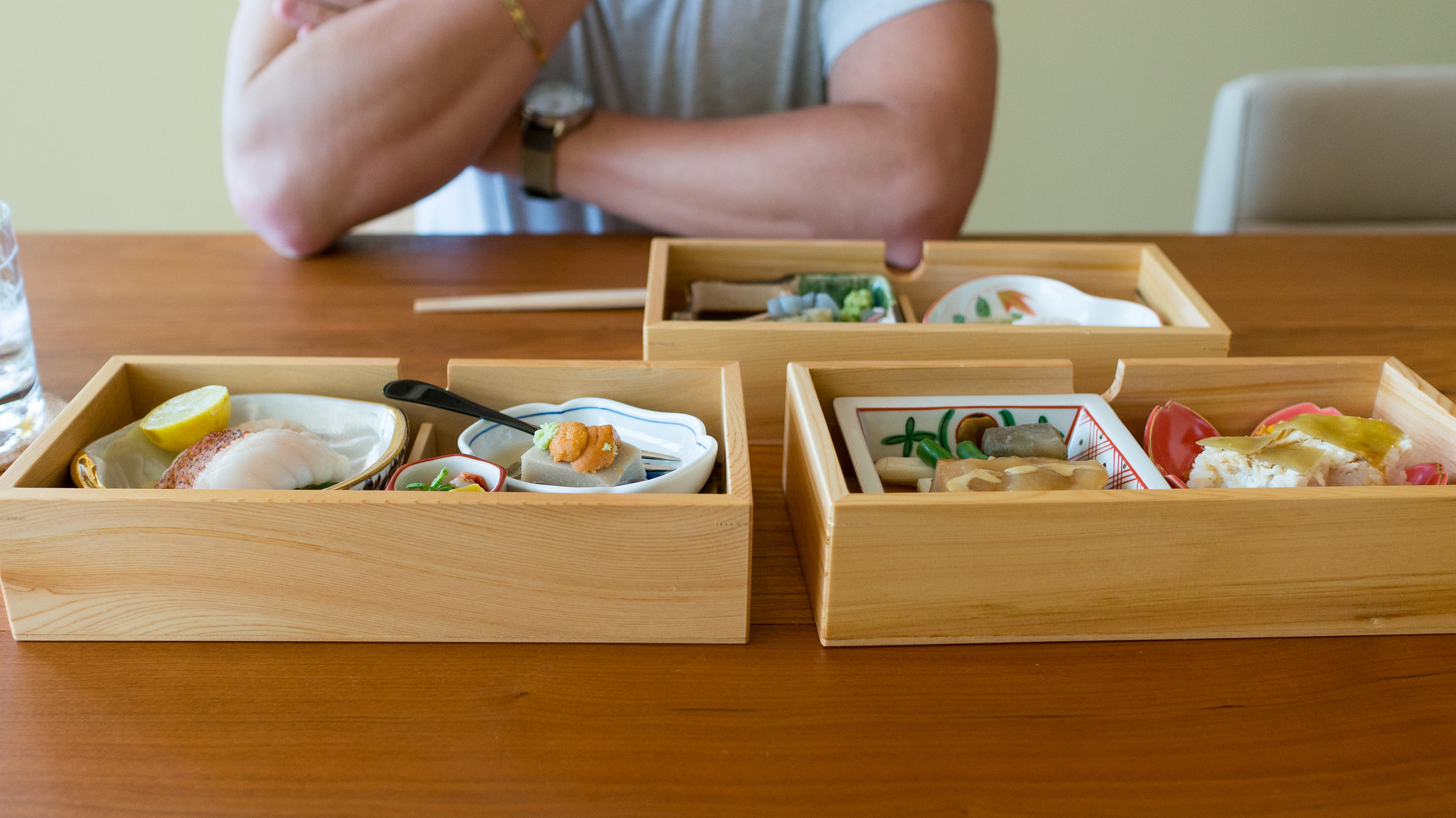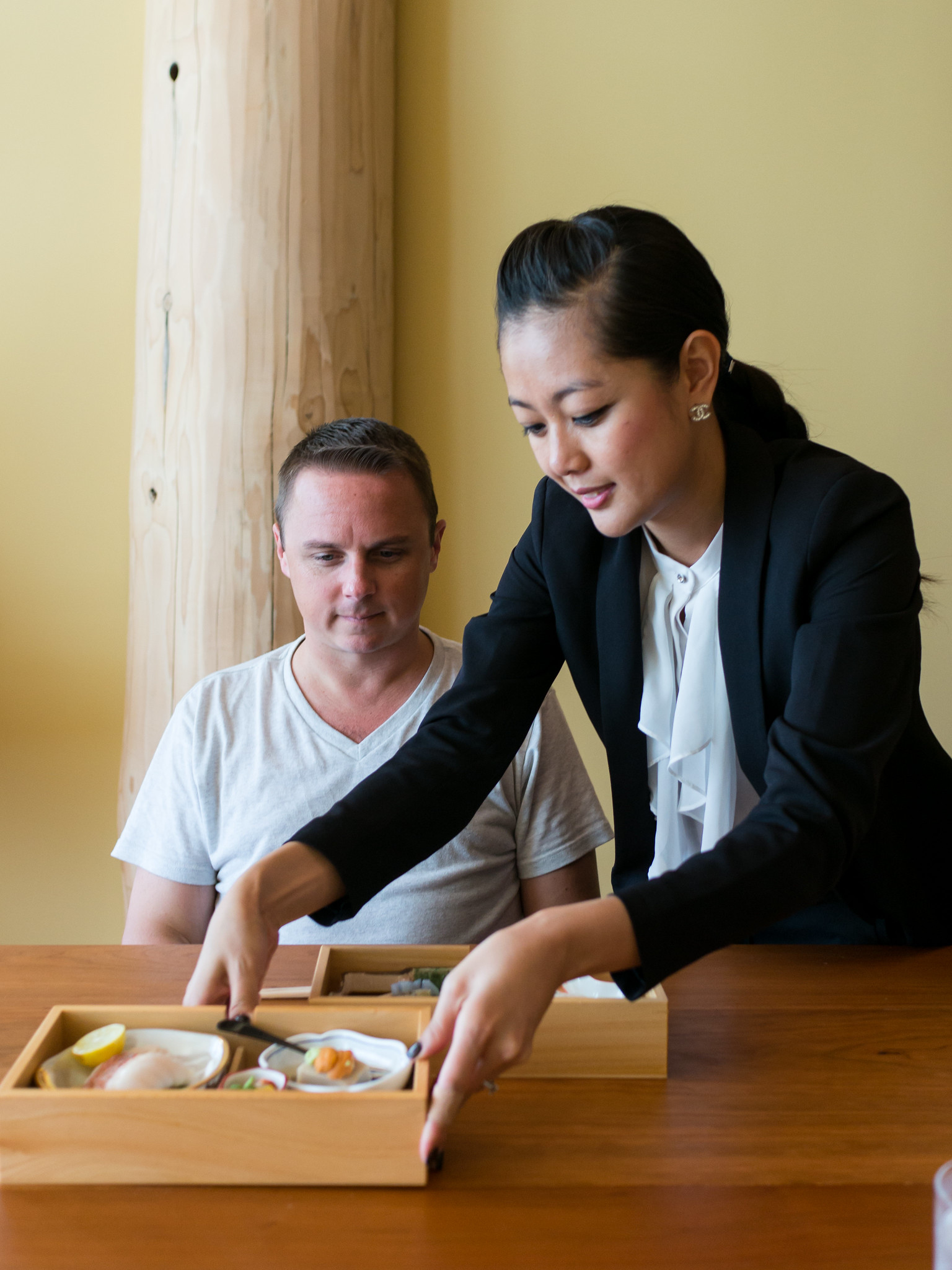My first taste of chef Shuji Hiyakawa's food came at an event last spring hosted by the Japanese Consulate in Miami, described as "Culinary Secrets of Traditional Washoku." "Washoku" literally means "Japanese food," but more specifically, the traditional cuisine of Japan (here's a good primer). After breaking down a whole tuna loin and making sushi of it, Chef Shuji also served a variety of other less heralded Japanese items: a seasonal dish of hotaru ika (firefly squid) with fresh bamboo shoots, yu choy in dashi broth with bonito flakes, sweet soy-braised root vegetables.
At the time, Chef Shuji, who made his way from Fukuoka, Japan to Miami by way of Philadelphia, where he had worked for several years as executive sushi chef for Morimoto, was weeks away from opening his own restaurant, Dashi. I went to Dashi shortly after it opened (you can read my first thoughts) and came away pretty impressed, albeit dismayed by the absence of a conventional sushi bar. But Dashi closed only a few months later after Hurricane Irma caused extensive damage to the River Yacht Club, where the restaurant was situated.
Fortunately, Chef Shuji had a back-up plan. Turns out he was already at work on another concept in a different space – and even better (for me, anyway), it was right along the path of my daily commute, in Miami's "Upper East Side" on N.E. 79th Street just over the Causeway from Miami Beach. In early January, Wabi Sabi by Shuji opened.
(You can see all my pictures in this Wabi Sabi by Shuji flickr set).
It's a simple but striking space, built out and decorated almost entirely by Chef Shuji himself. Across one wall sprawls a flock of multi-colored origami cranes. A table underneath is laid out with enough beautiful Japanese ceramics to serve a feast for about ten people (more on that later). Hanging from the ceiling and resting on counters are an abundance of kokedama moss ball planters. A few rough wood tables provide seating for maybe a dozen diners. At the back, there's a small kitchen island where you'll find Chef Shuji and assistant chef Maggie Hyams working away, and on some days, marketing and event coordinator Koko Makoto working the register, serving as hostess, and doing everything else that needs doing with grace and charm.
There's still no sushi bar. Rather, the idea of Wabi Sabi combines some Japanese tradition with the latest in American fast-casual trends: food in bowls. We all love food in bowls these days. Buddha bowls, poke bowls, power bowls, acai bowls – seems we'll eat anything if you put it in a bowl.[1] While some food trends are just plain stupid, this is one I can get behind: it's convenient, it's right-sized portioning, and when you put nice things in the bowl, it can be both delicious and aesthetically pleasing.
Which are also some of the things I love about Wabi Sabi. The menu at Wabi Sabi is straightforward: a choice of four different combinations of raw fish and accompaniments, over a choice of four different bases (sushi rice, a multigrain mixture, green tea soba noodles, or salad greens), with a choice of four different sauces – served in a bowl.[2] Any of the basic configurations will run you between $11 (for a vegetarian version which includes cucumber, avocado, scallion, seaweed salad, soy-marinated shiitake mushrooms, carrots and radishes) and $18 (for a fully decked out version with tuna, salmon, lump crab, tobiko, and an assortment of vegetables).
Or, for the ballers out there, there's also an "omakase" bowl, which features an ever-changing assortment of fish and seafood, much of it flown in straight from Tsukiji Market in Japan, served chirashi style over seasoned rice. That may mean blocks of fatty hamachi (yellotwail), ribbons of silky, clean kinmedai (golden-eye snapper), shimmering sayori (half-beak), creamy uni (sea urchin), silver-skinned aji (horse mackerel), house-cured iwashi (sardine) or kohada (gizzard shad), baubles of ikura (salmon roe), or any number of other possibilities, served over a bowl of seasoned rice, with seaweed salad, maybe some sprouts, maybe some soy-cured shiitake mushrooms, and a scatter of shredded nori batons.
Unlike the standard menu options, the omakase bowl is not cheap – pricing usually runs between $35 and $40, depending on what ingredients are featured that particular day. But if you add up what you would pay for a comparable sashimi or sushi order at any good sushi-ya – and the quality of the ingredients at Wabi Sabi is on par with what you'll find at the few places in Miami that fit that description – I think you'll find it to be roughly equivalent. It is also probably the easiest, most convenient way to eat some great sushi that you'll find in Miami, one that you can even take home and eat in front of the TV if you wish.
(continued ...)
Showing posts with label sushi. Show all posts
Showing posts with label sushi. Show all posts
Friday, June 15, 2018
Monday, August 7, 2017
first thoughts: Gaijin Izakaya by Cake | Midtown Miami
A couple years ago I got pretty excited over a tiny storefront along Biscayne Boulevard serving possibly the best Thai food I'd eaten in South Florida: Cake Thai Kitchen. Since then, Chef Cake (a/k/a Phuket Thongsodchareondee) has gone on to open a second, more polished Cake Thai in Wynwood, and has plans in the works for another location in the Citadel, a food hall and multi-purpose space currently in development in Little Haiti. It's been wonderful to watch the ascent of a chef whose talent is matched only by his humility.
And now, he's doing something else: a Japanese style izakaya in the Midtown Miami space of "The Gang," which he's calling "Gaijin Izakaya by Cake."[1] It's called "Gaijin" to dispel any notions of authenticity and because, well, Cake is as Japanese as I am, but it's really not such a huge leap: before opening his own Thai restaurant, Cake worked for years with chef Makoto Okuwa at Makoto in Bal Harbour, one of the best Japanese restaurants in town.[2] His menu at Gaijin is long and ambitious (I've not seen it posted online yet but I've got pictures: Page 1, Page 2 and Page 3) and after a couple visits, I've still only just made a dent in it, but have already found several highlights.
(You can see all my pictures in this Gaijin Izakaya by Cake flickr set.)
Back in the day, when Hiro's Yakko-San was in a tight little spot on West Dixie Highway and there was almost always an hour-long wait, they used to make okonomiyaki, an Osaka-style Japanese pancake / omelet type thing, usually topped with seafood and/or bacon, then bedazzled with Kewpie mayo, salty-tangy-sweet okonomi sauce, aonori, pickled ginger, and wispy katsuobushi shavings that wriggle in the heat. It disappeared from Yakko-San's menu some time around their move to a larger space, and is otherwise an elusive dish to find. But they're doing okonomiyaki at Gaijin, and it's a good version, with a hearty, chewy base and a layer of crisp, salty pork belly underneath all those toppings.
(continued ...)
Tuesday, April 18, 2017
first thoughts: Dashi | Miami River
Last month, I had the good fortune to be invited to an event at the Japanese Consulate in Miami, extolling the virtues of washoku, or the traditional cuisine of Japan. The event was hosted by the gracious consul general, Ken Okaniwa, but the headliner was chef Shuji Hiyakawa, who provided a live-action sushi-making display.
I had a feeling we were in good hands when Chef Hiyakawa started with the preparation of the rice, noting how every component is essential to the finished product: the blend of two vinegars he uses to season the rice, the wooden bowl in which it's prepared, which retains the right amount of heat and absorbs the right amount of excess liquid, the manner in which it's mixed, so that all the grains are seasoned, and neither too starchy nor too loose.
With the rice made, he went on to break down an entire loin of bluefin tuna. Given the depleted state of the species, I really would have preferred to see just about anything else on the cutting board. I suppose between its immense popularity in Japan, and its increasing popularity here in the U.S., and many diners' lack of understanding of the different cuts sourced from the same fish – the fattiest o-toro, the medium-fatty chu-toro, and the lean maguro – I understand why they would choose this for the demo. But particularly given the traditional washoku theme, I would have been grateful for a presentation on the virtues of the many other varieties of fish and seafood that can be made into sushi. After all, the bluefin obsession is actually a relatively recent thing – in Japan, it was mostly thought of as a trash fish until the 1970's (for further reading: "From Cat Food to Sushi Counter: the Strange Rise of the Bluefin Tuna," which is mostly based on Trevor Corson's book, "The Story of Sushi").
Nonetheless, it was an informative demonstration, and even better, was followed by an assortment of prepared dishes, which were accompanied by more than a dozen Japanese sakes, none of which are currently available for distribution in the U.S.
(More pictures from the event in this Culinary Secrets of Traditional Washoku flickr set).
As it turns out, this would not be the only opportunity to try Chef Hiyakawa's handiwork; he was only weeks away from opening his own restaurant in Miami. The chef, who hails from Fukuoka, Japan (where his father had a noodle shop), came to the U.S. to work for Masaharu Morimoto at his flagship Philadelphia restaurant, where he was executive sushi chef for several years. More recently, he wound his way to South Florida, until recently working as executive sushi chef at Kuro in the Hard Rock. He's now running his own place, Dashi, in a space inside the River Yacht Club.
(You can see all my pictures in this Dashi - Miami flickr set).
While his demo at the Japanese Consulate may have focused on traditional Japanese cuisine, Chef Hiyakawa's restaurant bridges old and new. In addition to nearly two dozen sushi and sashimi options, the menu includes prepared dishes that are both traditional (wagyu beef sukiyaki) and contemporary (white fish tiradito with sudachi juice and olive oil).
We sampled a couple of these prepared dishes while awaiting our sushi order. A salad of cha-soba (green tea noodles) was speckled with edamame, batons of asparagus, and slivers of shiitake mushroom steeped in soy sauce, all napped in a lightweight but umami-loaded variation of the restaurant's namesake dashi broth. A "House Poke Salad" was a rather un-poke-like but tasty combination of cubed tuna, tomatoes, avocado, cucumbers, and micro-greens in a ginger and miso dressing. It was a pretty sparse plate to bear a $25 price tag.
Mrs. F and I ordered an assortment of sushi which was presented all at once (pictured at top). Our order included kinmedai (golden eye snapper), madai (sea bream), hamachi (amberjack a/k/a yellowtail), aji (horse mackerel), shima aji (striped horse mackerel), masu kunsei (smoked sea trout), sake (salmon), botan ebi (sweet shrimp), ika (squid), anago (sea eel) and tamago (omelet). You see? There are a million wonderful things in the sea to eat other than bluefin tuna.
There were a few things I really liked about this.
First, Dashi's rice is indeed very good: well seasoned but not overwhelmingly so, with each grain distinct on your tongue, neither dry nor overly moist and clumpy. This was all the more impressive given that an order of this size, served all at once, necessarily has to sit for a time as each piece is being assembled (more on that later). Second, each piece was already brushed with nikiri, a glaze usually made of some combination of soy sauce, mirin, dashi and sake. Our server actually discouraged the use of a soy sauce dipping bowl at the table, as each piece had already been properly seasoned. Some also had been given a little extra garnish – a daub of miso on the salmon, freshly grated ginger on the aji, a shiso leaf tucked under the ika and a sprinkle of black salt on top. And finally, the fish – much of which is flown in from Japan, with its particular provenance listed on the menu (hamachi from Kyushu, kinmedai from Chiba, shima aji from Wakayama) – was very good.
A couple pieces of our order – the uni and the ikura, both from Hokkaido – were served separately in little bowls, with a small mound of rice, a sheet of nori, and the neta, almost like a free-form nigiri or a miniature donburi. This was kind of perfect, as I often treat these as my "dessert," and they were a couple of the best bites of the evening,
It's not Naoe level quality, but Dashi is probably close to on par with what I've had at Makoto or Myumi. Prices are steep, even more so than Makoto, which ain't cheap: other than the tamago on the low end and Hokkaido uni on the high end, our order ran between $7-10 per piece, compared to mostly $5-7 per piece at Makoto. They have a nice selection of sakes and Japanese beers to accompany your dinner, as well as some Japanese inspired cocktails.
Dashi's location, as a sort of restaurant-inside-a-restaurant within the River Yacht Club,[1] is itself a draw, with a vista that looks across the Miami River in one direction towards downtown and in the other towards Brickell, including the recently re-lit "Miami Line" designed by artist Rockne Krebs which stretches along the Metrorail bridge. Unfortunately, there is one glaring omission from the design of the restaurant, which otherwise is a pretty slick and scenic indoor-outdoor space: there's no sushi bar. And not to sound like a prima donna, but this is very nearly a deal-breaker for me. If you want good sushi, there's simply no substitute for being right at the counter, with each piece passed across to you as it's made. The rice can be packed looser, the neta doesn't sit and dry out as other pieces are made; it's just impossible to duplicate that when you're making a dozen pieces at a time which sit for several minutes before they get to the table.[2]
But the combination of good food and a waterfront view is surprisingly elusive in Miami; it's a combination Dashi achieves, if you're willing to take the view as a trade-off for the absence of a sushi bar, and pay a premium for it.
Dashi
401 SW 3rd Avenue, Miami, Florida
786.870.5304
[1] This is an intriguing piece of property, situated on the Brickell side of the Miami River nearly underneath I-95 and next to Jose Marti Park.The main restaurant there apparently has a "rotating chefs-in-residence" program, though what I mostly noticed while walking through to Dashi was the "untz untz" music and what appeared to be a session of Advanced White People Dancing Badly on the outdoor dance floor.
[2] Of course, the converse isn't necessarily true either: everything can get screwed up even when you're right at the sushi bar. A few weeks ago I visited another recently opened Miami sushi den, which had a beautiful 8-seat sushi counter manned by five hard-working sushi chefs. It also had one of the most interesting and exotic selections of fish that I've seen offered in Miami. Unfortunately, the rice was so bad – dry, under-seasoned, stiff – and much of the fish was also so dried out and consequently lacking flavor, that I'm reluctant to even give the place a second try. It's a shame, because it was an ambitious and exciting assortment that otherwise would be right in my sweet spot.
[2] Of course, the converse isn't necessarily true either: everything can get screwed up even when you're right at the sushi bar. A few weeks ago I visited another recently opened Miami sushi den, which had a beautiful 8-seat sushi counter manned by five hard-working sushi chefs. It also had one of the most interesting and exotic selections of fish that I've seen offered in Miami. Unfortunately, the rice was so bad – dry, under-seasoned, stiff – and much of the fish was also so dried out and consequently lacking flavor, that I'm reluctant to even give the place a second try. It's a shame, because it was an ambitious and exciting assortment that otherwise would be right in my sweet spot.
Monday, March 20, 2017
Sushi Deli / Japanese Market - an appreciation
Many, many years ago, when I first started writing this blog, I made a big mistake: I wrote about Sushi Deli.
It's not that my recommendation was off target. The once-tiny sushi counter[1] inside a Japanese market (called, simply enough, "Japanese Market") was the classic hidden gem, a place where, among the packaged ramen noodles and bags of rice and frozen fish and togarashi spice mixes, you could get ridiculously good sushi, some of it flown in from Japan every week, at an incredibly reasonable price. There is surely no place I'd visited more often, or that had been the source of more satisfying meals, despite the peculiar hours (closed Mondays and Tuesdays, and never open later than 6:30 p.m. – a closing time which moved progressively earlier over the years as the place became ever more popular).[2]
Truth is, a good portion of what I know and love about sushi, I learned sitting at that counter: the joy of the many different varieties of hikari mono, or silver-skinned fish, the differences in flavor and texture among uni from different parts of the world, the seasonality of sushi offerings and the sense of paying attention to what is best when. But perhaps most of all, I learned the importance of trust and loyalty.
I don't claim to be particularly close to Chef Kushi: our brief conversations across the counter would mostly be limited to what was good that day, or his last trip home to Japan, or how his golf game was doing, or – most frequently – how he was working too hard. But he knew how much I appreciated his food, and his passion; and I always felt appreciated there too. From what I can gather, the root word of "omakase" is "entrust." After several visits, I entrusted my meals to Michio, and more important, he trusted me enough to let me experience many things I might never have tasted in Miami otherwise.
You could go full omakase at Sushi Deli if you wished, which would often bring a procession of sashimi and other items. But my standard order was something of a variation on the theme: I would ask for six pieces of nigiri – whatever Chef Kushi chose[3] – along with a battera roll, an Osaka-style pressed sushi roll topped with vinegar-cured saba, a sheet of cured seaweed, and toasted sesame seeds, plus, usually, a "triple-egg" temaki (uni, ikura, and quail egg) for "dessert." And this was how I discovered any number of things: sayori (halfbeak, or needlefish), with a shiny strip of silver along its gorgeous translucent flesh, tai (Japanese snapper) lightly cured in kombu to enhance its flavor, kazunoko (herring roe), a new years' tradition. Often, these came adorned: grated fresh ginger, a daub of uni, a smidgen of yuzu kosho, a sprinkle of sesame seeds, a dot of miso or ume paste, a sheet of cured seaweed, a sliver of shiso.
(You can see several of these in this Sushi Deli / Japanese Market flickr set).
Though Michio is, in his way, very much old fashioned – I've tried, unsuccessfully, to count the dozens of signs posted around the restaurant warning customers not to use cellphones and not to take pictures, among other rules – these creative elaborations show that he actually was not particularly bound by tradition. So, too, does the fact that he had women working behind the sushi bar – including his daughter Erika, who, it's reported, is looking to open her own place in the neighborhood within the next year.
My mistake was that some things are perhaps better left unsaid. Not that I claim credit for blowing it up on the blog. FFT has never exactly raked in the page views, and I could probably name every person who visited the site in those first few months when I first wrote about Sushi Deli. And many folks with exponentially bigger megaphones than myself have been guilty of breaking what some of us eventually tried to make the "First Rule of Sushi Deli" (You do not talk about Sushi Deli), like chefs Michelle Bernstein, José Andrés, Norman Van Aken, and Kevin Cory of Naoe. But that post is also among the top 25 in all-time visits here, many of those over the past few years, so I guess I'm guilty too.
As Sushi Deli became more and more popular the past couple years, I unfortunately found myself going less and less often (of course, considering there was a stretch that I made almost weekly visits, that was bound to happen). What had once been a place where we would just pop in on Sunday afternoons had become one where you had to show up a half-hour before they opened to get on the list for seats. When I was able to score a seat, Michio – who is now a very spry 68 years old – would be in non-stop motion, and often seemed as harried as a Tokyo salaryman.[4] Maybe, Sushi Deli should have stayed a bit more under the radar. Selfishly, anyway, it would have been better for me.
Chef Kushi himself always seemed ambivalent at best about Sushi Deli's increasing popularity. In fact, he often seemed to actively resist it. Those shortened hours, and all those rules, seemed at least partially designed to discourage customers – or certain types of customers, anyway. In a story last month which announced the impending closure, he admitted, "I wish I could choose the customers. Each of them."[5] And this isn't the first time he thought about calling it quits. A few years ago, he started a rumor that he was about to close – which may have been serious, or may have just been a ploy to try to get the restaurant listing off of Yelp.
But this time, it's for real. All the merchandise had been cleared off the shelves, and the several dozen folks who were lined up outside yesterday – some as early as 8:30 a.m. – will be Sushi Deli's last customers.
I will miss it dearly. I can't even begin to count the moments of quiet happiness I've had at that counter over the years, many of them shared with my family. But I am thrilled for Chef Kushi and his lovely wife to finally get to relax, as they so rightfully deserve. And I am incredibly excited for what's in store from the next generation ... but maybe I shouldn't say any more about that.
[1] Not that it ever got very big: over the years, they perhaps doubled the original capacity of about a dozen, if you counted a small table in the back underneath the Japanese video DVDs.
[2] It's entirely possible there's also no place where our kids ate more frequently than Sushi Deli, as we've been taking them from a very young age. Frod Jr.'s regular order at first was the salmon teriyaki lunch plate, and he eventually branched out to the rest of the menu. Little Miss F's regular order was the crunchy shrimp roll, though she came to like the battera roll nearly as much as her dad.
[3] On my last visit to Sushi Deli a couple weeks ago, another customer saw this coming out and asked Chef Kushi what it was. He opened his eyes wide and exclaimed "I don't know!"
[4] It is customary if you're drinking sake at the sushi bar to offer your itamae a pour, but a few years ago, Mrs. Kushi cut Michio off because the sake would slow him down too much in the afternoons.
[5] I was always baffled by the people who would wait an hour for a spot there, and then order a California roll and a spicy tuna roll. But maybe even worse were the ponderous blowhards loudly "educating" their companions about Japanese food, usually while drowning Chef Kushi's sushi in a viscous slurry of soy sauce and wasabi.
[2] It's entirely possible there's also no place where our kids ate more frequently than Sushi Deli, as we've been taking them from a very young age. Frod Jr.'s regular order at first was the salmon teriyaki lunch plate, and he eventually branched out to the rest of the menu. Little Miss F's regular order was the crunchy shrimp roll, though she came to like the battera roll nearly as much as her dad.
[3] On my last visit to Sushi Deli a couple weeks ago, another customer saw this coming out and asked Chef Kushi what it was. He opened his eyes wide and exclaimed "I don't know!"
[4] It is customary if you're drinking sake at the sushi bar to offer your itamae a pour, but a few years ago, Mrs. Kushi cut Michio off because the sake would slow him down too much in the afternoons.
[5] I was always baffled by the people who would wait an hour for a spot there, and then order a California roll and a spicy tuna roll. But maybe even worse were the ponderous blowhards loudly "educating" their companions about Japanese food, usually while drowning Chef Kushi's sushi in a viscous slurry of soy sauce and wasabi.
Tuesday, November 1, 2016
best thing i ate last week: aji nigiri at Myumi
There's been a deficit of "best thing I ate last week" posts the past few weeks on account of travel – Seattle a couple weeks ago, including a wonderful return to Willows Inn, and San Francisco this past weekend. Let's try to fill in the gaps. Since I already wrote about our last Cobaya dinner with Gabe Fenton at Bourbon Steak, and will hopefully get around to writing about Seattle and San Francisco shortly, b.t.i.a.l.w. honors for the week before last goes to a bite from an omakase meal at Myumi, now situated in Wynwood Yard.
I wrote about my first visit to Myumi last year. The quick version: an omakase-only sushi tasting menu, served out of a truck, of surprisingly great quality. And my latest experience was every bit as good as my first. The highlights included shima aji with a nice snap to the flesh, meaty steelhead trout, salted and peppered and seared, and one of my favorite fish, the silver-skinned, polka-dotted kohada, lightly cured in vinegar.
But maybe my favorite bite among the ten courses (for $60) was this nigiri of aji, the pleasantly oily, fatty fishiness of the minced horse mackerel counterbalanced by the zing of ginger and scallion, then topped with toasted sesame seeds.
(You can see the full set of pictures from my most recent meal at Myumi in this Myumi - Wynwood flickr set).
Monday, July 11, 2016
best thing i ate last week: hokkaido uni at Shuko (New York City)
Some sort of sound had involuntarily come out of my mouth. I'm not sure exactly what it was; it may have been a moan. It may have been a giddy chuckle. But when I came back to my senses, I saw that everyone on the other side of the counter was looking at me with an expression somewhere between bemusement and shock.
Shuko is not a stereotypically austere, somber sushi bar: the soundtrack is dominated by old-school hip-hop, and the chefs fist-bump regulars across the bar. But still, whatever I'd done had caught everyone's attention.
It was triggered by this bite of Hokkaido uni: the lobes of sea urchin cold and creamy, with a flavor both briny and fruity, like an oceanic peach, tucked over a pillow of rice into a gunkan maki of crisp nori. Beautiful stuff, worth embarrassing yourself a little bit.
You can see all the pictures from our omakase dinner at Shuko in this Shuko - New York City flickr set.
Shuko
47 E. 12th Street, New York, NY
212.228.6088
Shuko is not a stereotypically austere, somber sushi bar: the soundtrack is dominated by old-school hip-hop, and the chefs fist-bump regulars across the bar. But still, whatever I'd done had caught everyone's attention.
It was triggered by this bite of Hokkaido uni: the lobes of sea urchin cold and creamy, with a flavor both briny and fruity, like an oceanic peach, tucked over a pillow of rice into a gunkan maki of crisp nori. Beautiful stuff, worth embarrassing yourself a little bit.
You can see all the pictures from our omakase dinner at Shuko in this Shuko - New York City flickr set.
Shuko
47 E. 12th Street, New York, NY
212.228.6088
Tuesday, May 17, 2016
best thing i ate last week: magurozuke nigiri at Myumi
Last summer, I wrote some "first thoughts" about Myumi – a food truck doing an omakase-only sushi service out of a lot in Wynwood. I came away impressed: fish, rice, knife-work, garnishes were all quite good, and indeed if I had any complaint, it was only that they could be a tad heavy-handed with the embellishments, hiding the quality of the base components. By Miami sushi standards, I rated it quite highly; for sushi coming from a food truck, it was downright exceptional.
Since I last wrote about Myumi, the truck moved a few blocks to Wynwood Yard, where it now shares space with a funky outdoor bar, Mortar & Pistil, a vegetable garden, as well as a few other food trucks. The sushi is still every bit as good as my initial experience, and now you can stroll a few steps and grab a cocktail or a beer (I highly recommend the locally made M.I.A. Megamix pale ale) to accompany your meal, and finish it with some frilly shaved ice cream from Mr. Bing.
The ten rounds that made up our omakase selection had about a 2/3 overlap with my earlier visit. This time around, my favorite bite among many good ones was the magurozuke, the glistening tranche of lean tuna marinated, if my taste buds are on target, in a blend of shoyu, mirin and dashi, and topped with a dab of fresh wasabi.
You can see the rest of the pictures from this meal towards the bottom of this Myumi - Miami (Wynwood) flickr set.
Monday, May 16, 2016
first thoughts: Dragonfly Izakaya | Doral
Nearly a year ago, I posted some thoughts prompted by an Eater "Future Week" feature on the future of Miami dining. One of the things I predicted was that we would start seeing more independent restaurants in less trendy neighborhoods: places like Doral and Kendall, with lower rents, lots of potential customers, and not much competition other than chains. I'll confess that as a Miami Beach resident, I don't get out that way very often (honestly, I'd usually rather chew off one of my own limbs than drive on SR-836 West). But I braved the westward traffic last week to pay a visit to Dragonfly Izakaya, which opened last month.[1] The menu, which promised seafood from Tsukiji Market and robata-grilled "neck to tail" yakitori, had lots of the right words on it.
(You can see all my pictures in this Dragonfly Izakaya and Fish Market flickr set.)
It's a big venue, with a long and busy indoor/outdoor bar, seating for probably about 100, and an open kitchen with a robata grill and sushi bar. At the entrance is a small space that's slated for use as a fish market, though it's not yet up and running. Dragonfly's a good-looking room, which incorporates Japanese elements into the design – big sake barrels, wooden planks over the robata grill with the menu written in kanji – but not in a completely over-the-top Epcot kind of way.
We started at the bar, which during happy hour features $7 cocktails (including a nice pre-batched Old Fashioned) and several sub-$10 snacks, including a solid rendition of chicken karaage for $5 (that's not the entire portion – someone ate half of it before I got there). After the happy hour clock wound down, we shifted our way over to the sushi bar to sample through the rest of the menu.
We started with a round from the robata grill. The selection was not as broad as the menu promised: a "Neck-to-Tail Tasting Menu" listed several of the more exotic chicken bits, but some of my favorites were not yet available: bonjiri (chicken butt, from the end of the tailbone), seseri (neck, with lots of nice crispy skin) and tsukune (ground chicken meatballs, not sure why these would be so difficult to drum up). But we still did OK – pictured here and working clockwise from top left, eryngii (king oyster mushrooms) doused with butter and lemon, reba (chicken liver) swiped with tare, kawa (crisp, fatty chicken skin), and shio saba (salted mackerel). In the bottom left corner is one of my favorites, okonomiyaki, a sort of savory Japanese pancake studded with cabbage and seafood, then bedecked with Kewpie mayo, okonomi sauce, aonori, beni shoga (red pickled ginger), and wispy bonito flakes. Off-screen: tontoro, grilled pork cheek, served with a nutty sesame oil dipping sauce.
Of these, the highlights were the saba – it was powerfully salty, but the mackerel was tender, oily and fishy in a welcome way – and the okonimiyaki, a treat that's difficult to find here in Miami. The chicken items were good, but lacked that fantastic balance of juicy and crisp that I've experienced at yakitoris in Japan (though that's setting the bar pretty high).
We followed with a round of nigiri: here, from back to front and left to right, hamachi (yellowtail), saba (mackerel), hotate (scallop), ika (squid), ikura (salmon roe), and mirugai (geoduck). Off-screen: ama ebi (sweet shrimp), served in the customary fashion accompanied by their fried heads. Again, the offerings on hand were a bit shy of what was listed on the menu: no o-toro, uni or aji. no kinmedai or aji from Tsukiji market. But from what we sampled, the fish was of pretty good quality – I especially enjoyed the firm snap of the mirugai. The rice was a bit cold, stiff and underseasoned for my taste. The chef also sent over a tuna kobashi for us to sample, with ruby-hued cubes of fish given a riveting dash of kimchi spice and a savory hit of toasted sesame oil, served with slivered avocado and airy rice crackers for some DIY Japanese nachos.
(continued ...)
Monday, June 1, 2015
first thoughts: Myumi Omakase Sushi Truck - Miami (Wynwood)
For a long time, I've been bemoaning the dearth of good sushi in Miami. I'm not even talking about in comparison to what I had in Japan; just good quality fish and properly prepared rice is frustratingly difficult to find.
On the very high end there is Naoe, but it requires a commitment of at least a couple hundred bucks and a few hours. I'm also a fan of Makoto in Bal Harbour, but it's become a difficult reservation many days. I've actually got an excellent little spot in my neighborhood, but it's so small, its hours are so limited, and it's become so popular that it is now the Sushi Bar That Shall Not Be Named.
Then what? I had a good meal when I went omakase at Morimoto (pictures here), but the sushi wasn't really the highlight. A few years ago I made a return to Nobu after several years away and the sushi was reasonably good, but the value was entirely out of whack, as has always been the case there. I was actually pleasantly surprised by my first visit to the recently opened Soho Bay (pictures here), a Brazilian import that poached a Nobu alum, Ricardo Sauri, for its executive chef. I'll have to go back and try more.
What else? I'm not nearly as enamored of Matsuri as some folks are. I've got a couple izakayas I love – Hiro's Yakko-San and Su Shin – that serve sushi, but it's not their strong suit.[1] I'll go to Pubbelly Sushi for their reimagined Japanese gastropub stuff – a good rendition of tuna poke, the hamachi ceviche with tostones, the ridiculous but delicious pork belly and clam roll – but it's also not a place to go to for traditional nigiri. Everything else I've tried is crap.
Enter Myumi. It's not your typical sushi bar. In fact, it's a truck – a converted FedEx delivery truck, currently stationed in a lot in Wynwood. Which I suppose makes a bit of sense: I've read that sushi was originally street food. From that truck, Chef Ryo Kato[2] serves an omakase only (chef's choice) menu with only two choices: do you want to spend $40 or $60?
The omakase-only format means they know exactly what they need to buy, so they buy some very good stuff: fish and shellfish straight in from Japan, uni and ikura from Alaska, tuna from Ecuador. Some items get just a brush of shoyu, others more elaborate garnishes. Our $60, 12-course selection went like this:
(You can see all my pictures in this Myumi - Miami (Wynwood) flickr set).
(continued ...)
Monday, September 29, 2014
Uni Sashimi Bar - Boston
I knew once we'd decided to go to Boston that we'd have to visit a Ken Oringer place. He's a chef I've followed from afar for years, one whose menus I'd read and feel like I could already taste them. It was tough to pass on Clio and Toro, but I've been on something of a seafood kick lately and so Uni Sashimi Bar was the choice.
Our dinner at Uni didn't start particularly well, though. It took nearly ten minutes after being seated before our waiter even graced us with his presence, and then an equal amount of time before he could make a return visit to bring menus and pour water. It was an oddly ignominious introduction to the place, particularly given that the entire restaurant is about the size of a reasonably spacious living room, and we could see him rearranging chairs around empty tables as we anxiously awaited some semblance of service.
(You can see all my pictures in this Uni Sashimi Bar flickr set).
Fortunately, it was all uphill once the food started coming out. The menu at Uni is composed almost exclusively of small plates of raw fish, but the accompaniments and presentations are much more genre-bending than the "sashimi bar" in the name would suggest. As just one example, the namesake sea urchin roe is smoked, then folded onto a soup spoon together with a raw quail egg, a mound of osetra caviar, and a sprinkle of snipped chives for one luxurious, indulgent bite.
One of my favorite fish, silver-skinned shima aji, came cut into thick ribbons and paired with orange segments, goji berries and a black sesame drizzle, the sweet-tart fruit a nice foil for the oily flesh of the fish. Lubina (sea bass) was done in a Mediterranean inspired style, with green charmoula, plumped golden raisins and a sprinkle of preserved lemon gremolata. An elegantly presented razor clam invoked Catalan flavors: romesco sauce, Marcona almonds, crispy migas.
(continued ...)
Our dinner at Uni didn't start particularly well, though. It took nearly ten minutes after being seated before our waiter even graced us with his presence, and then an equal amount of time before he could make a return visit to bring menus and pour water. It was an oddly ignominious introduction to the place, particularly given that the entire restaurant is about the size of a reasonably spacious living room, and we could see him rearranging chairs around empty tables as we anxiously awaited some semblance of service.
(You can see all my pictures in this Uni Sashimi Bar flickr set).
Fortunately, it was all uphill once the food started coming out. The menu at Uni is composed almost exclusively of small plates of raw fish, but the accompaniments and presentations are much more genre-bending than the "sashimi bar" in the name would suggest. As just one example, the namesake sea urchin roe is smoked, then folded onto a soup spoon together with a raw quail egg, a mound of osetra caviar, and a sprinkle of snipped chives for one luxurious, indulgent bite.
One of my favorite fish, silver-skinned shima aji, came cut into thick ribbons and paired with orange segments, goji berries and a black sesame drizzle, the sweet-tart fruit a nice foil for the oily flesh of the fish. Lubina (sea bass) was done in a Mediterranean inspired style, with green charmoula, plumped golden raisins and a sprinkle of preserved lemon gremolata. An elegantly presented razor clam invoked Catalan flavors: romesco sauce, Marcona almonds, crispy migas.
(continued ...)
Saturday, July 5, 2014
first thoughts: N by Naoe - Brickell Key, Miami
When Kevin Cory moved his omakase temple, Naoe, from Sunny Isles to Brickell Key two years ago, he also leased an adjoining space which he said was eventually going to be used for lunch service. That day has finally come. And this is a lunch like no other you'll find in Miami.
Let's open the box on N by Naoe. (You can see all my pictures in this N by Naoe flickr set; you can also read my thoughts on Naoe here).
A few minutes after you're seated, a three-tiered bento box is brought to your table. It's unpacked to reveal six compartments, each stocked with several different items – similar in style and quality to the elaborate bento that starts a meal at Naoe.
(continued ...)
Let's open the box on N by Naoe. (You can see all my pictures in this N by Naoe flickr set; you can also read my thoughts on Naoe here).
A few minutes after you're seated, a three-tiered bento box is brought to your table. It's unpacked to reveal six compartments, each stocked with several different items – similar in style and quality to the elaborate bento that starts a meal at Naoe.
(continued ...)
Friday, March 21, 2014
"through the narrow door" | Sushi Yoshitake - 鮨よしたけ - Tokyo
Perhaps it was over-ambitious to have made a dinner reservation for the evening of our arrival in Tokyo, after about seventeen hours of travel. But it seemed foolish to miss any opportunity. As it turned out, we had just enough time to retrieve our bags from the airport carousel, hop on the train, transfer to the subway, get lost in the Shinbashi Station, find our way (with some assistance) to the hotel, check in, drop our bags, splash some water on our faces, and hail a taxi to Sushi Yoshitake in nearby Ginza.
When we arrived, our driver pointed up to make sure we understood that the restaurant was on the third floor of what appeared to be a nondescript office building. After exiting the elevator, we spotted the kanji that matched the picture our hotel concierge had provided us, fumbled with the door,[1] and then nearly stumbled right on top of six diners seated along a wooden counter in a room smaller than many walk-in closets. A hostess politely shooed us back outside, then directed us across the landing to what appeared to be a cupboard built into the wall. We assumed she was going to put our coats away there. Instead, she opened the door and beckoned us inside.
We stepped through the narrow door, crouched into a tight passageway, and emerged into an even smaller room - if the first one was a walk-in closet, this was a broom closet - which was our private little sushi den for the evening. So this is what a Michelin three-star restaurant looks like in Tokyo.
(You can see all my pictures in this Sushi Yoshitake flickr set).
The chef,[2] in halting English, asked if we had any dietary restrictions. "We eat everything." That was put to the test immediately. The first course, our first bite in Japan, was a chawanmushi topped with fugu shirako. I fully processed these words[3] only after having taken a couple bites. "Fugu" is pufferfish - potentially lethally poisonous if prepared improperly. "Shirako" is milt or "soft roe," i.e., the fish's, er, laden male genitalia. The shirako is one of the most sought-after delicacies from the fugu fish, and February, it turns out, is high season for both fugu and shirako in Japan.[4]
Blistered from a quick sear on the grill, the shirako was warm, creamy and subtly oceanic, its texture and flavor nearly blending into the silky, dashi-inflected custard on which it rested - a warming welcome on a cold evening. It was neither as gross as you might think nor, frankly, so delicious as to warrant risking death.[5]
Several rounds of sashimi followed. Octopus, cut in big blocks, had three distinct textures - the thin membrane and suckers with an almost crispy pellicle, beneath which a delicate, gelatinous layer surrounded the main part of the tentacle, which was tender with just a bit of pleasing chew to it. Next, stacked slivers of pink-hued amadei (tilefish), just the skin seared, were served with a soy sauce infused with the fish's bones.
(continued ...)
When we arrived, our driver pointed up to make sure we understood that the restaurant was on the third floor of what appeared to be a nondescript office building. After exiting the elevator, we spotted the kanji that matched the picture our hotel concierge had provided us, fumbled with the door,[1] and then nearly stumbled right on top of six diners seated along a wooden counter in a room smaller than many walk-in closets. A hostess politely shooed us back outside, then directed us across the landing to what appeared to be a cupboard built into the wall. We assumed she was going to put our coats away there. Instead, she opened the door and beckoned us inside.
We stepped through the narrow door, crouched into a tight passageway, and emerged into an even smaller room - if the first one was a walk-in closet, this was a broom closet - which was our private little sushi den for the evening. So this is what a Michelin three-star restaurant looks like in Tokyo.
(You can see all my pictures in this Sushi Yoshitake flickr set).
The chef,[2] in halting English, asked if we had any dietary restrictions. "We eat everything." That was put to the test immediately. The first course, our first bite in Japan, was a chawanmushi topped with fugu shirako. I fully processed these words[3] only after having taken a couple bites. "Fugu" is pufferfish - potentially lethally poisonous if prepared improperly. "Shirako" is milt or "soft roe," i.e., the fish's, er, laden male genitalia. The shirako is one of the most sought-after delicacies from the fugu fish, and February, it turns out, is high season for both fugu and shirako in Japan.[4]
Blistered from a quick sear on the grill, the shirako was warm, creamy and subtly oceanic, its texture and flavor nearly blending into the silky, dashi-inflected custard on which it rested - a warming welcome on a cold evening. It was neither as gross as you might think nor, frankly, so delicious as to warrant risking death.[5]
Several rounds of sashimi followed. Octopus, cut in big blocks, had three distinct textures - the thin membrane and suckers with an almost crispy pellicle, beneath which a delicate, gelatinous layer surrounded the main part of the tentacle, which was tender with just a bit of pleasing chew to it. Next, stacked slivers of pink-hued amadei (tilefish), just the skin seared, were served with a soy sauce infused with the fish's bones.
(continued ...)
Thursday, May 24, 2012
Pubbelly Sushi - Miami Beach
When the gang behind Pubbelly first announced that their expansion plans included a sushi bar, I'll admit I was more than a bit dubious. I like Pubbelly's mashup of Asian, gastropub, and Spanish stylings, but when it comes to sushi I'm something of a purist. I want great fresh seafood, properly cooked and seasoned rice, and really, that's it. Those goofy "specialty" rolls, stuffed with cream cheese, deep fried and drenched in cloyingly sweet "eel sauce," are just not for me. And when you start going cross-cultural with it, you quickly run the risk of turning into something truly frightful like Guy Fieri's sushi-bbq abomination, Tex Wasabi's.[1] These are dangerous waters.
But I'm also willing to engage in some culinary "suspension of disbelief," at least once. And even though it is not remotely the kind of sushi bar I'd regularly patronize, I nonetheless find myself regularly patronizing Pubbelly Sushi.
Like its parent, Pubbelly Sushi is a tight, cozy space - brick walls, exposed ductwork, loud alt.rock, mismatched wood furnishings, and about 6-8 seats at a bar along the back. The primary feature of the menu is a list of about ten "Pubbelly Rolls," many sounding much like those overwrought concoctions I usually avoid. But the menu is also populated with about an equal number of izakaya-like "Snacks," a selection of various things packed into "New England Style Rolls," several robata grilled items, a few composed "Pubbelly Sashimi" dishes, various sides, as well as a somewhat abbreviated selection of basic sushi and sashimi (you can also, if you choose, order just about any of the Americanized canon of "California Rolls" or "Dragon Rolls" that is to your liking).
(You can see all my pictures in this Pubbelly Sushi flickr set - apologies for the wonky lighting).
It surely says something that I went in a complete skeptic and came out a fan. It helped to start with the shishito peppers from the "Snacks" section. My first visit, the blistered peppers were served with an unlikely combination of raita, pine nuts, and roasted peppers. It was the kind of combination that makes no sense until you try it, at which time everything just clicks. On a subsequent visit, these were instead served with miso and pistachios, which was almost as good.
I passed up the "Pubbelly Sashimi" dish that combined bigeye tuna with burrata cheese and tomato, but I did sample the Japanese madai snapper, paired with yuzu, mandarin, serrano chile and aji jus. That's a pretty long and strongly flavored list of ingredients for a pretty delicate fish. And while I can't exactly say that it brought out, rather than obscured, any hidden nuance in the madai, it was a pleasingly bold combination of flavors, more in the neighborhood of a Peruvian tiradito than anything else.
These kinds of cross-cultural tendencies manifest themselves throughout the menu, and happen to result in some of the best dishes. Another was the tostones with ceviche, a Caribbean direction this time, the crispy, salty disks of fried plantain both foil and vehicle for a small glass jar's worth of hamachi ceviche, its flavors tugged gently back toward Asia with soy, ginger and yuzu.
So far, so good. So how about those "Pubbelly Rolls"?
(continued ...)
Sunday, April 29, 2012
The Return of Naoe - Downtown Miami
When I wrote about my first experience of stumbling upon Naoe, I described it as seeming almost like a dream: a tiny 17-seat jewel-box of a restaurant serving a bento box of gorgeous Japanese dishes followed by a procession of pristine nigiri, all entirely "omakase" or chef's choice. But it was real, and I went back several more times just to make sure. (You can find recaps of some subsequent meals here, here and here.)
In December, Naoe had to vacate its Sunny Isles space when the landlord hatched other plans for it. They closed up shop and began work on a new space on Brickell Key, adjacent to downtown Miami. The new venue reopened last week, and I made my first visit this past Thursday - exactly three years after my first post on Naoe.
I'm not usually a superstitious person, but I do worry that a place can lose its "mojo" when it moves locations.[1] Any such worries about Naoe were absolved by my visit to Naoe on Brickell Key.
Walking into the new space was again something like a dream: it looks almost like a mirror image of the original spot in Sunny Isles. It has the same smooth hinoki wood bar stretching in front of the open kitchen; it has the same austere grey-brown tones throughout the dining room; it has the same pinpoint halogens which literally put the spotlight on the food. There's actually less seating than there was in the original spot, and Chef Kevin Cory will only be serving eight diners per service.[2]
There have been some other minor tweaks. Instead of the $26 bento box followed by nigiri priced by the piece, Naoe now offers an $85 omakase menu that includes both the bento box and eight pieces of nigiri. Additional rounds (either repeat visits to items served earlier or, possibly, some different items) can then be added a la carte. Though bargain-hunters might rue the loss of the $26 bento, I have trouble believing anyone ever went to Naoe without sampling some sushi as well. If they did, they were missing out.
(You can see all my pictures in this Naoe April 26, 2012 flickr set).
The food is every bit as good as it ever was:
Bento box with sashimi of cobia and scallop mantle, with Japanese seaweed, shiso and freshly grated wasabi; tsubugai (whelk, or sea snail); fried whiting; wilted mizuna; tofu with uni sauce and walnuts; sardine and portobello mushroom rice with daikon nukazuke.[3] A bowl of miso soup with puréed corn was served alongside.
Salmon belly nigiri. Always the first nigiri served at Naoe. Perenially one of my favorite bites.
(continued ...)
Monday, November 21, 2011
Naoe Revisited - November 2011
When I wrote about my first visit to Naoe shortly after it opened, it felt much like recalling a dream with near-perfect lucidity from the night before. Though I've posted about Naoe since then, I've found it increasingly difficult to capture the experience in words - or new words, anyway. It's not that each meal is any less exceptional than the first; they have all been outstanding. Rather, there is such a pristine simplicity and purity to Chef Kevin Cory's style that it evades my descriptive abilities.
This is not about high-tech cooking methods. It's not about surprising flavor combinations. It's just about the best ingredients that can be found, prepared with thought, sensitivity and care.
I was back to Naoe again last week and had what may have been my best meal yet. As has been the case since the 17-seat restaurant opened, the meal followed the same pattern. The menu offers no choices other than a list of drinks: Sapporo on tap, a selection of sakes from Chef Cory's family in Japan, Japanese soft drinks like Ramune or Calpico. Dinner begins - about a half hour after you're seated - with a bento box of various treats accompanied by a soup (still priced at $26 like when Naoe opened 2 1/2 years ago), followed by a procession of sushi until you say "Uncle."
This time, the bento featured cobia sashimi, cut a bit thick to accentuate the snap in the texture of the raw fish. Alongside, ribbons of seaweed, a julienne of shiso, freshly grated wasabi, and a rare seasonal treat, kazunoko (herring roe), the strips of delicate eggs with a wonderful pop to their texture.
The next compartment housed a variety of cooked items: shirako (cod milt), simmered in soy and sake with a touch of sansho pepper; grilled sanma (a/k/a saury or pike mackerel), tsubugai (whelk), eggplant, served cold, lotus root, carrot, and a chestnut coated in little beads of mullet roe.
The remaining compartments held a tranche of cobia, steamed with a mantle of gooey mountain potato and a jelled dashi broth, studded with gingko nuts and topped with slivers of mitsuba, a delicate Japanese herb; and sardine rice, with slivers of koji-pickled daikon. A savory cup of shiitake mushroom broth, inflected with a hint of lemon peel, was served alongside.
(continued ...)
Subscribe to:
Posts (Atom)

